2019 archived news
November

The University of Alaska Fairbanks and U.S. Department of Energy Advanced Manufacturing Office are teaming up to host the Arctic Advanced Manufacturing Innovator or AAMI Program. You are encouraged to apply for this program.
If selected as an Arctic innovator, you will be paired with a UAF researcher and a Department of Energy National Laboratory researcher who are well aligned with your hard technology focus area and who will serve as a mentor and collaborator for your project. You will also receive commercialization and entrepreneurial support from UAF. The University of Alaska Fairbanks and U.S. Department of Energy Advanced Manufacturing Office are teaming up to host the Arctic Advanced Manufacturing Innovator or AAMI Program. You are encouraged to apply for this program.
The AAMI program supports early-career innovators with fresh ideas and innovative approaches to address fundamental hard technology (physical devices) manufacturing challenges in Alaska. You will have a unique opportunity to move your early-stage concept to commercialization with support from mentors.
Selected Arctic innovators will receive a competitive stipend ranging from $72,000 to $110,000 per year based on academic level and experience, as well as other benefits including training and travel, health insurance, relocation costs and lab space.
Innovators with strong ties to Alaska will be given preference. Learn more about this upcoming program at Zintellect website.

Fairbanks Startup Weekend will be led by UAF students this year, and four of the event organizers attended the Columbia Missouri Startup Weekend over the weekend of October 18.
Startup Weekend is a 54-hour event where you experience the highs, lows, fun and pressure that make up life at a startup. As you learn how to create a real company, you'll meet the very best mentors, investors, cofounders and sponsors who are ready to help you get started.
The UAF students participated in the Columbia event as a way to learn more about Startup Weekend from both the organizer’s side and the participant’s side. The four students joined different competing teams and worked on many different ideas.
The UAF students made such a great impression that they received a donation from the Columbia event organizers to help kick-off the Fairbanks Startup Weekend. The Fairbanks Startup Weekend kicks off on November 15. Go to https://www.techstars.com/communities for more information.
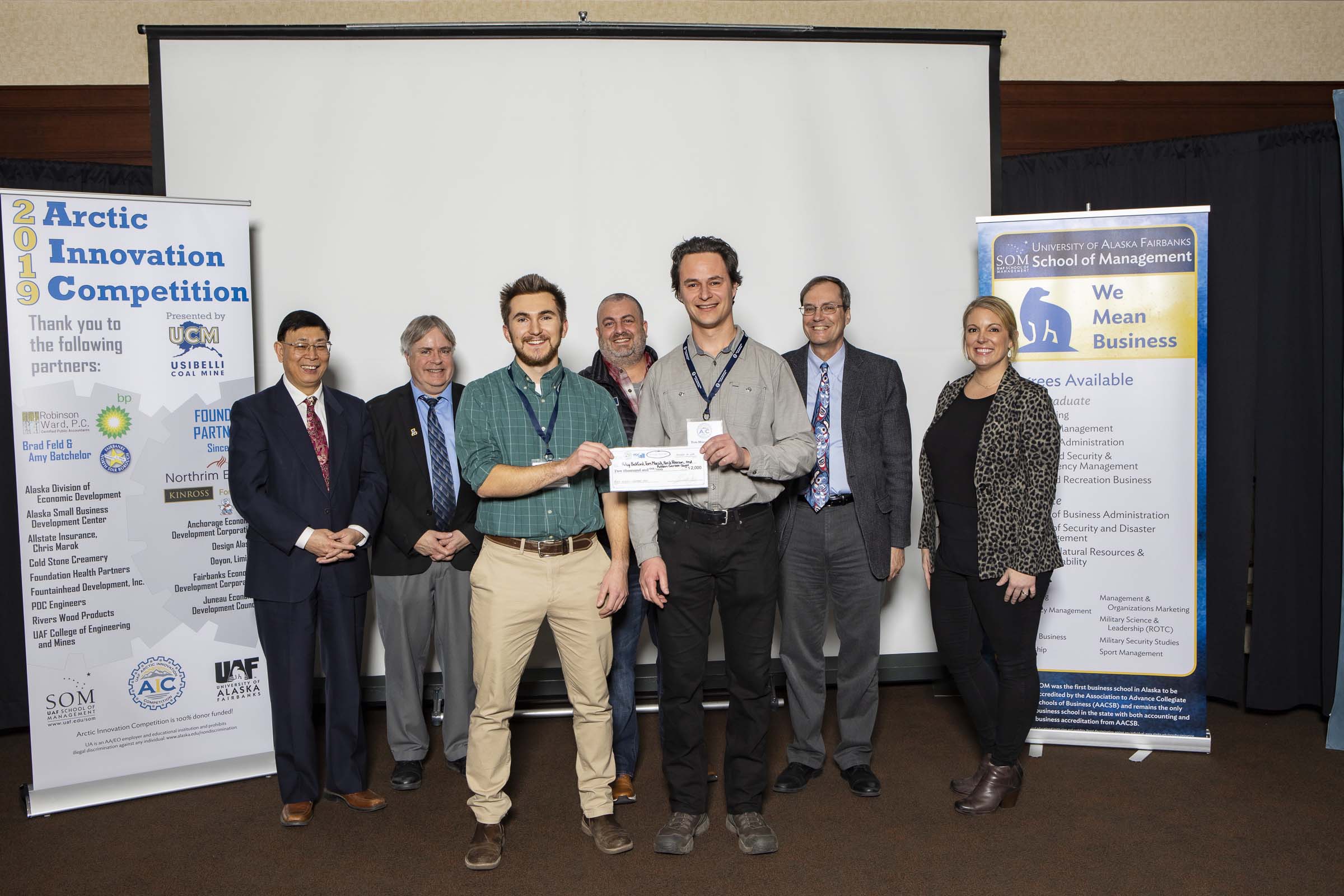
At this year’s Arctic Innovation Competition, Riley Bickford and Tom Marsik of UAF’s Alaska Center for Energy and Power pitched the Arctic Dual Hood for Heat Recovery Ventilation invention. The project was awarded a kicker prize of $2,000 for the best Arctic-related idea. With the cash and support from ACEP, the Cold Climate Housing Research Center, the U.S. Office of Naval Research and the University of Alaska Fairbanks Bristol Bay Campus, the team plans to test a prototype this winter at the CCHRC Research and Testing Facility.
The goal is to create a combined intake/exhaust unit to simplify heat and energy recovery in cold climate ventilation systems.
The project started at CCHRC and gained speed when Bickford chose the idea as his undergraduate research endeavor. He received guidance from Marsik, who holds a joint position with ACEP and CCHRC.
The innovation also won the 2018–2019 Commercialization: Best Overall IDEAs Award at UAF. The Innovative Disclosures and Entrepreneurial Activities, or IDEAs, awards recognize entrepreneurial individuals who have developed innovative approaches to research, teaching and service.
Bickford graduated from UAF in spring 2019 and continues to work on the invention as an ACEP employee. The project team now includes CCHRC’s Vanessa Stevens, Robbin Garber-Slaght and Conor Sosebee.
For more information on the dual hood innovation, contact Riley Bickford at rjbickford@alaska.edu.

Startup Week brings entrepreneurs, local leaders and friends together for one week to build momentum around Alaska’s entrepreneurial opportunities.
This is the third annual Alaska Startup Week. From November 18 to 24, events in Fairbanks and across the state will highlight Alaska entrepreneurs as well as programs and initiatives supporting innovation and commercialization. As with last year’s Startup Week, the events coincide with Global Entrepreneurship Week.
Find out more about the upcoming events during Startup Week at https://www.techstars.com/communities/startup-week.
If you are interested in holding an event in Fairbanks or getting involved in an existing event, please contact Fairbanks co-lead Peter Webley, pwwebley@alaska.edu.

University of Alaska Southeast faculty Christian Kienholz, Eran Hood and Jason Amundson were recently awarded a grant from the Earth Science Instrumentation Program at the National Science Foundation to purchase two mapping-grade drones.
The drones will be used for a variety of environmental applications, including studying glacier outburst floods and glacier ice loss, quantifying snow accumulation in avalanche terrain, and looking at landscape evolution in glacier river valleys. UAS students will use the drones in a spring 2020 class entitled Using Drones for Environmental Monitoring taught by Hood and fellow UAS faculty member Sanjay Pyare.
Students will learn how to conduct drone campaigns as well as how to use structure-from-motion photogrammetry to model surface topography from photos captured during drone campaigns. The class will also prepare students for the drone pilot exam administered by the Federal Aviation Administration. Future plans include establishing a drone lab at UAS to enhance student and faculty opportunities to study environmental change in southeast Alaska.

The Alaska State Committee for Research invites interested persons to nominate outstanding science, engineering and technology innovators to be inducted into the SCoR Alaska Innovators Hall of Fame. Nominees selected by SCoR will be members of the 2020 class and will be inducted at the Innovation Summit in Juneau on February 26 and 27, 2020. Nominations must be submitted no later than November 15, 2019.
SCoR created the Alaska Innovators Hall of Fame in 2014 to celebrate and honor outstanding individuals who put Alaska on the map as leaders in innovation and to contribute to Alaska’s growing culture of innovation.
The SCoR Alaska Innovators Hall of Fame selection subcommittee will review nomination documents and publicly available information about nominees to develop a list of recommended inductees. This list will then be submitted to the full SCoR committee for consideration and selection. The University of Alaska vice president for academic and student affairs will notify all nominees of their selection status.
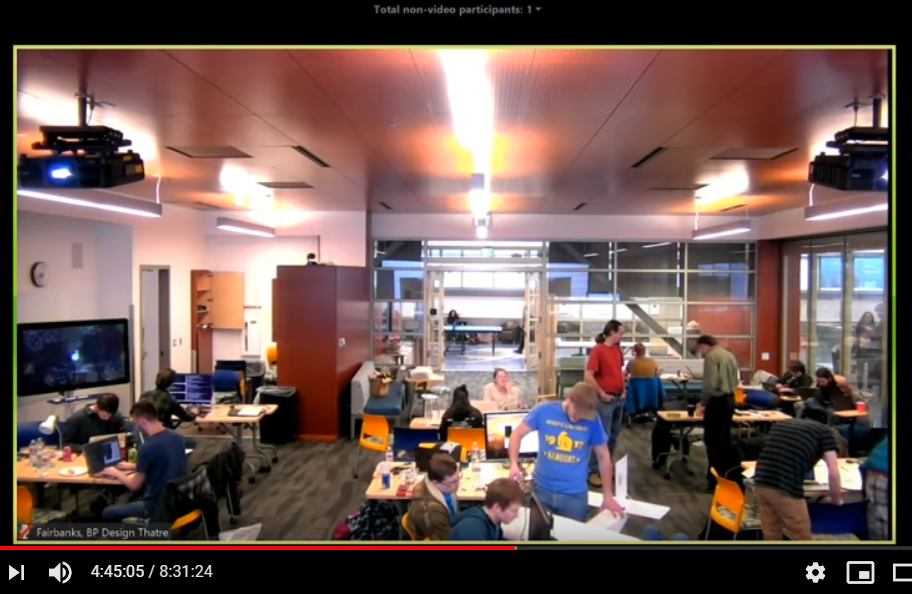
UAF Hackathon Club and the Alaska Developer Alliance hosted the first statewide hAKathon on October 11, 2019.
The event had locations in Fairbanks, Anchorage and Juneau. This year there were nearly 50 participants in Fairbanks and almost 100 across Alaska in 15 teams.
The participants worked on a variety of innovative projects, ranging from an automated drone that could identify and put out forest fires to an inexpensive indoor door opener, which won the Startup Idea Pitch award.
Every team won an award, including a pair of Servo-driven glasses that would protect you from seeing scary things during the month of October, which won the Most Straight-up Hilarious and Conversation Starter prize.

The UIF program empowers students around the world to become agents of change in higher education. Fellows create opportunities that help their peers unlock their creative potential and develop the design-centered mindset required to take on complex challenges in today’s world.
The fellowship begins with a six-week online training program, followed by an in-person workshop at the Silicon Valley meetup. At the meetup, fellows connect with one another to build on their online training. They also receive year-round mentoring and represent their university program at national conferences and events.
Next summer, Mason will attend the in-person workshop, bringing back what she learns to the teaching faculty at UAF in a series of workshops.
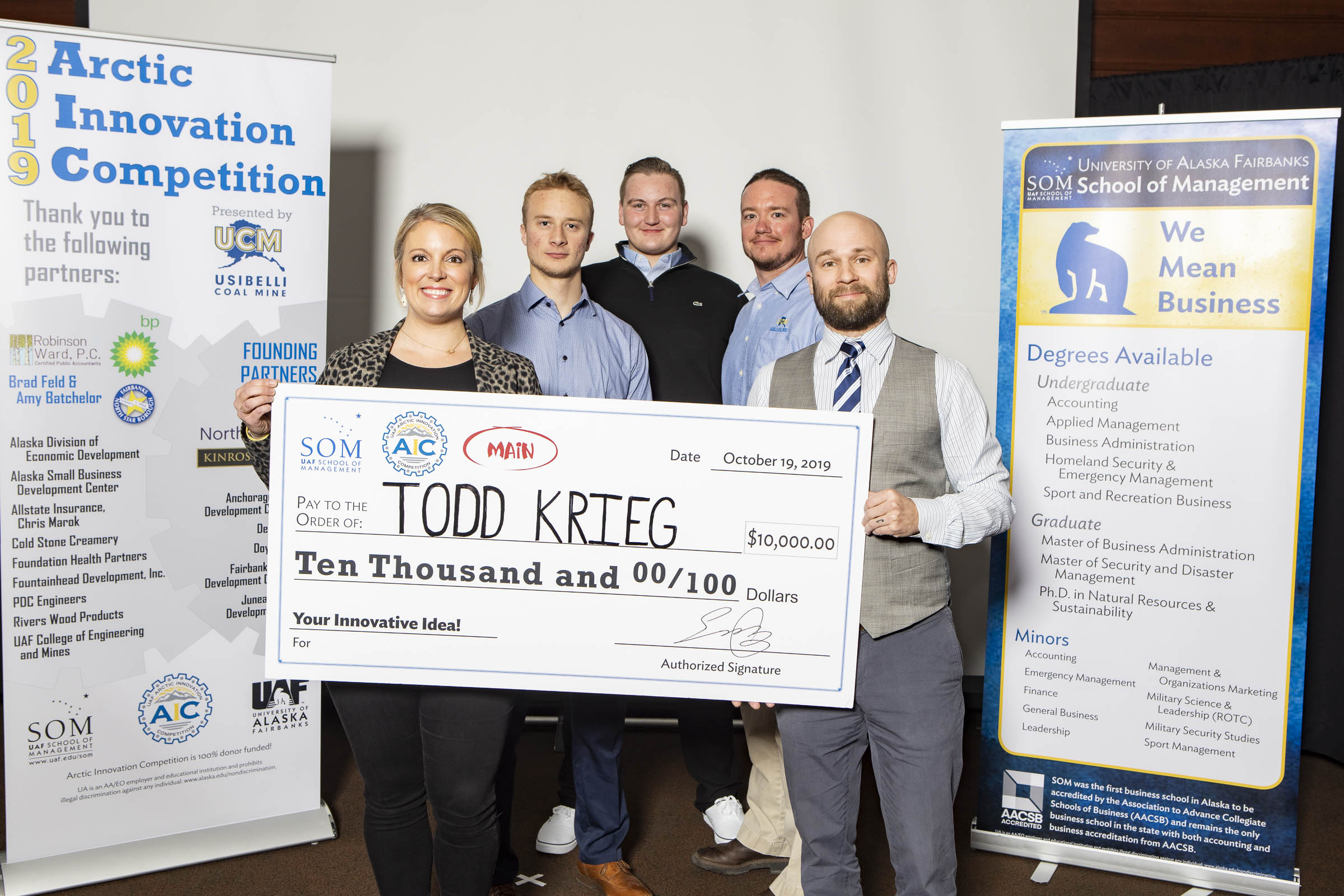
The top prize of $10,000 in the main division, for ages 18 and up, was awarded to Todd Krieg for fish wheel salmon selector. The selector improves on the classic fish wheel by safely returning coho and chinook salmon to the river to continue spawning while allowing other, more abundant species to be harvested. Other winners included a marine mammal attractant dispensing method to guide them away from oil spills, and a high school virtual hall pass.
Visit https://sites.google.com/alaska.edu/uaf-aic/home for full details.
October

The Center ICE Seed Fund is designed to help "nudge" promising technologies and companies forward, and give them opportunities to acquire more funding for technology and research development.
We are excited to congratulate Center ICE Seed Fund recipient companies Barati Medical and Rhizoform who have received new funding from the Small Business Innovation Research (SBIR) fund.
UAA Professor Philippe Amstislavski, founder of Rhizoform LLC received EPSCoR funding that was distributed by the Alaska Small Business Development Center's TREND program for an SBIR Phase I application to fund additional development of his novel method of growing insulation from fungus to use in shipping seafood from Alaska to locations that have banned traditional Styrofoam insulation. Phase 0 offer grants up to $5,000 to assist with SBIR/ Small Business Technology Transfer (STTR) proposal writing.
Barati Medical LLC, led by UAF research scientist Bahareh Barati, received a highly competitive award from National Institute of Health (NIH) SBIR for her wireless optical imager. See the story below for more on Bahareh’s journey to receiving an SBIR award.
Does your innovation need a boost? The Center ICE Seed Fund is now accepting applications for up to $7,000 for non-UA affiliated projects and up to $25,000 for UA students, staff and faculty with an innovation that needs a nudge! Visit https://www.uaf.edu/centerice/seed-funding/ or contact Ky Holland at hrholland@alaska.edu for more information.

Congratulations to co-founders Nigel Sharp and Jonathan Kamler of UAF for their win at the Accelerate Alaska pitch contest in the "newcomers" category.
Aquagga Inc. was started this summer as a spin-out of a UAF technology invented by co-founders Kamler (Ph.D. Candidate at UAF) and Sharp (UAF's Entrepreneur in Residence). Their mission is to make a social impact for the world by developing technologies that can both treat and find added value from wastewater while providing innovative solutions which are more energy-efficient and save water. Their tagline is "Wet Waste Redefined".
One 55-gallon barrel of the green sludge (human waste) has a recoverable energy content of around two gallons of diesel fuel, which in turn has an economic value equivalent to about two weeks of wages for the people dumping the waste. In some areas, up to 25,000 barrels per day of waste is dumped in areas like the Korogocho slum in Nairobi, Kenya. Along with creating a biohazard, they are dumping the equivalent of six months worth of wages into the river on a daily basis. The economic impact of avoiding that is staggering. Aquagga is developing technologies to help change the waste into wages.
Aquagga has been making great progress this year, winning second place in the Alaska Seed Fund competition, invited to the U.S. Department of Energy's Innovation XLab event in Tennessee, being granted a TREND SBIR Phase 0 award, and most recently taking the "Best New Pitch" award at Accelerate Alaska.
The Aquagga team plans to continue developing their product ideas based on customer and market discovery work they will engage in this fall. If you'd like to learn more about the team please sign up for their updates at www.aquagga.com.

Bahareh Barati was the recipient of high competitive SBIR award. Photo by Amanda Byrd.
Most biomedical graduate students don’t go into school thinking about starting a business. But, most students are not Bahareh Barati. And, she credits Drexel University for instilling in her innovation, entrepreneurialism, and commercialization.
Bahareh, lead of Barati Medical LLC, was the recent recipient of an extremely competitive Phase I National Institute of Health (NIH) Small Business Innovation Research (SBIR) award, one of just a handful ever awarded to UAF and Alaska. This award is used for feasibility studies and to test the market need for technology.
Bahareh’s technology is focused on a miniaturized optical imaging device to monitor brain injuries in small animal models. Particularly, this SBIR grant focuses on monitoring how brain infarction (tissue death due to lack of blood supply) changes over time in animal models of stroke. The key to this particular technology is that it is wireless and can monitor the brain’s health and function as the animals go along with their daily activity without having to do any further surgeries or anesthesia. Any technology available today costs five-times Bahareh’s technology, and medical practitioners would need to anesthetize the animal whenever they want to do any imaging, and their results are not reliable. Bahareh’s are. Her product will improve the value of preclinical stroke research and accelerate the path to clinical trials with reduced failure rates and associated costs.
Receiving an SBIR award
Most researchers do not get awarded an SBIR award on the first try. Bahareh says, “you need to be very persistent. You have to keep trying and trying.”
Bahareh’s first attempt placed in the top 50% of the applications. One of the great things about the SBIR application review process is that submitters receive detailed feedback from the individual reviewers. And, if you are in the top 50% of reviewed scores, your application will be discussed at a study section, by all of the reviewers. Successful applicants receive a summary of what was discussed by reviewers, and the discussion of Bahareh’s technology concluded that while they liked the technology, it was ‘too risky.’
This risk, however, is the actual purpose of the SBIR award – to provide funding to test a risky idea, and to prove the feasibility of this idea to start the long process toward commercialization. And, this technology was a high-risk high-reward concept. The reviewers agreed that there were some challenges to overcome, but if it does work it will become a very important tool for stroke research.
“I really worked on the concept, and I knew it [the technology] was too risky,” says Bahareh. “I believed in it, and if it worked it was going to change the paradigm of stroke experiments.’
Initial funding
It took a few small grants and some personal expense to get Bahareh and Barati Medical to the point of the SBIR award. Bahareh was initially funded by an SBIR Phase 0 grant from The TREND: Technology Research and Development Center of Alaska to help write the initial SBIR grant applications.
She completed a two-week NSF Innovation Corps with LA node (IN-LA) to interview potential customers to see whether her technology might solve a real-world problem.
The company was also awarded funding through the first round of the Alaska Center ICE Seed Fund in the category of Innovation at an Inflection Point with a focus on removing risks that will help develop the path to launch a business and overcome challenges to becoming investable.
“It’s an exciting time at UAF,” says Bahareh. “There’s initiative and momentum to help startup companies with OIPC and Center ICE.”
This funding gave Barati Medical (a partnership between Bahareh and Dr. Kambiz Pourrezaei, her PhD adviser at Drexel University) momentum to keep moving forward on their research and to reduce the personal expense they were inputting on the project.
“The seed fund from Center ICE was really nice. It helped us hire a part-time engineer to speed up things.”
The Phase I SBIR award gives small businesses awards ranging from $150,000 up to $400,000 to test the feasibility of their product and prove it is worth investing in. And, if feasible and you have a good business and commercialization plan, then you can apply for a Phase II SBIR award. This award is up to $1 million in non-diluted funding, so the business retains all of the funding and intellectual property rights.
“On top of funding, it gives you credibility, too. Venture capitalists are more willing to invest in your technology when they see you have passed that very difficult step,” says Bahareh.
Connecting with Students
In the meantime, Bahareh learned about the Students2Startups program being launched by Center ICE. She was able to pitch her company in the 5 minutes allotted and received a lot of interest from the students. She interviewed six students and ended up hiring former OIPC intern Gerald Montuya, in part because he was proactive and well-versed in the startup culture. Bahareh enjoys working with students as they bring in new insights and unbiased ideas to a project.
“I love working with students, it’s my passion,” says Bahareh. “I know it takes a lot of time and energy training them and they may only stay with you for a short time, but I really like them enjoying their experience and leaving me with some gained knowledge. It’s a great opportunity for them to advance their careers and build their resumes.”
The Student2Startups program provides funding for students to be placed in working roles in startup companies. Where a startup may not have the funding available to hire a student, and students are seeking work opportunities in cutting edge technologies, it is the perfect match for the two.
Gerald is still working with Bahareh, he received undergraduate research funding through the Biomedical Learning and Student Training (BLaST) program. He is excited to apply this technology to animal experiments.
Bahareh’s next step is to apply for the NIH I-Corps program which is open to Phase I awardees. This is a 8-week customer discovery program to further explore the need for this technology. This program is perfect to Phase I SBIR recipients during their feasibility assessments. During the I-Corps program, if customer discovery shows that there is, in fact, a market for your product, then this gives you great credibility to apply toward your Phase II application.
Bahareh’s initial customer discovery included interviews with scientists and researchers at university laboratories as well as pharmaceutical companies. In the longer I-Corps program, the theme for who you should interview changes to achieve a broad market analysis.
I-Corps at NIH is an entrepreneurship training program created specifically with small businesses in life sciences in mind. The 8-week program supports Phase I SBIR- and STTR-funded companies with their commercialization efforts. By conducting 100 interviews, small businesses refine their target customer, key product, and market needs. The interviews help participants make new networks, establish partnerships, and build commercialization plans that accurately address the needs of their target market.
Bahareh has a lot of supporters at UAF, but it has been her persistence, her ability to take in all feedback, hard work and great mentors that got her on the path to success. We are excited to see where the technology goes and we are thrilled that UAF is producing groundbreaking research in the biomedical field.

Want to learn more about intellectual property and the technology transfer process? Want to know how to get engaged? Want to know more about the events and programs that are happening on campus and across the State?
OIPC and Center ICE can come to your class, faculty/staff meeting, or student club to talk more. You will learn more about the Alaska Community Challenge, NSF I-Corps program, Alaska Startup Week and Weekend as well as the IDEAs awards and other funding opportunities.
For more information, contact OIPC Faculty Ambassador, Peter Webley at pwwebley@alaska.edu
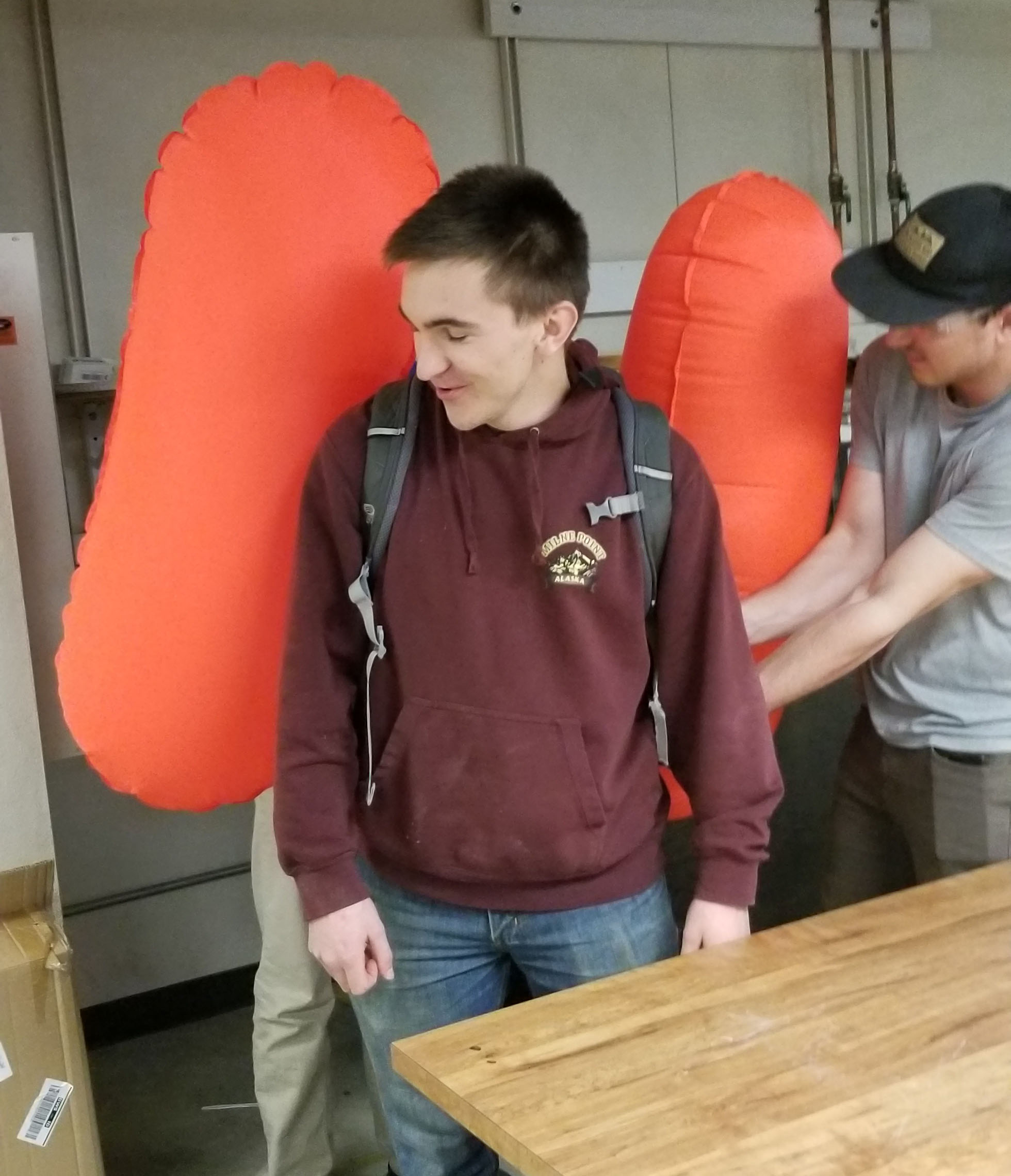
UA Students - Alaskan companies, startups, nonprofit organizations, public agencies, and UA faculty are sharing their challenges or problems with UA students that would make an amazing capstone project!
Come find out if there is a project that interests you or your team. Last year, a UA student team of Mechanical Engineers worked with Entrepreneur Ray Huot to develop Avy Pouch. They worked on the invention during their Capstone project and won the 2018-2019 IDEAs award for Young Innovators.
For more information, contact OIPC Technology Commercialization Officer, Ky Holland at hrholland@alaska.edu or AK-Center-ICE-Challenge
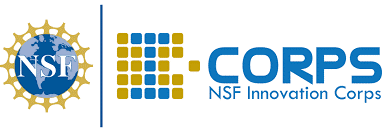
Another cohort for UA’s I-Corps program is forming, so do not miss out. The National Science Foundation’s Innovation Corps offers up to $2500 from a federally funded program to accelerate STEM projects for both University and non-University teams toward commercialization and validation of their ideas.
Learn more here, and contact Nigel.Sharp@alaska.edu for more information.
 The Center ICE Seed Fund awarded 8 grants, from $5,000 to $25,000, in 2018 to University
and community innovators working on commercialization or technical challenges that
needed a "nudge" to make some critical progress.
The Center ICE Seed Fund awarded 8 grants, from $5,000 to $25,000, in 2018 to University
and community innovators working on commercialization or technical challenges that
needed a "nudge" to make some critical progress.
The Center ICE Seed Fund is accepting additional proposals for consideration for fall 2019 awards. Visit www.uaf.edu/centerice/seed-funding/ for more information and to apply.
September
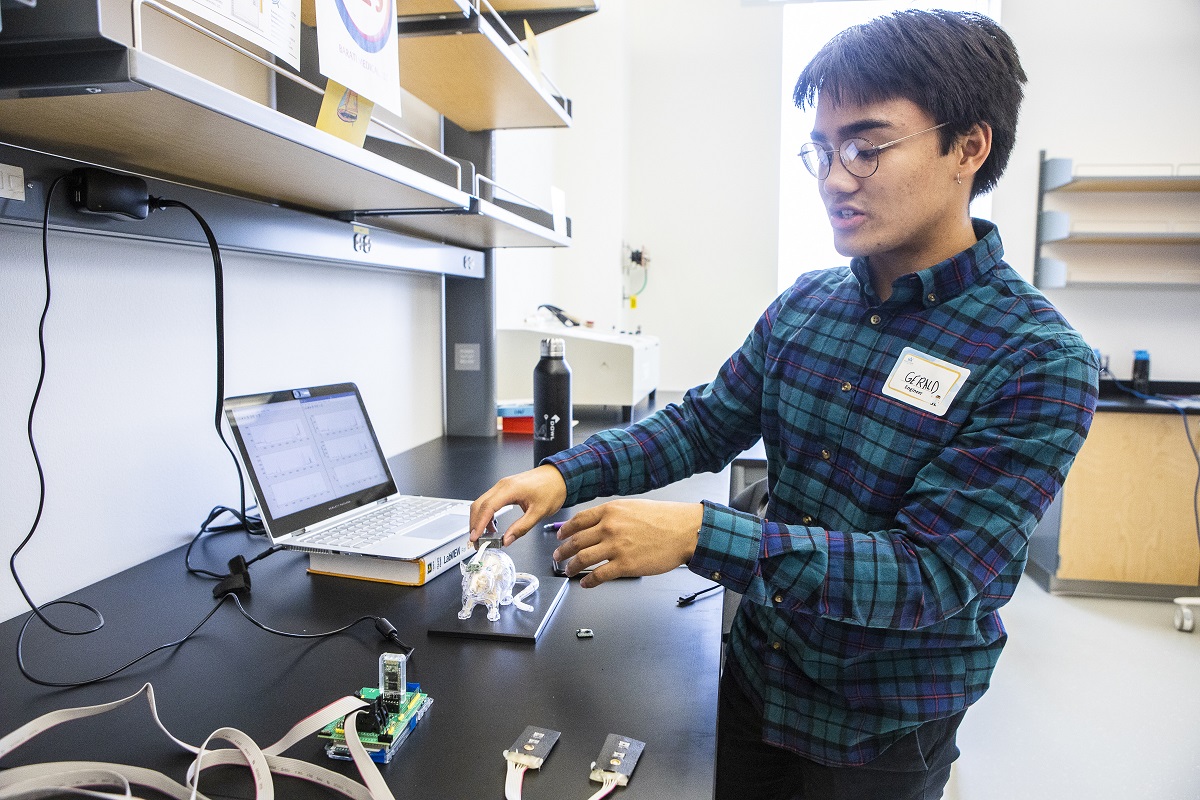
Gerald at work in Center ICE co-working space as part of Students2Startups, summer 2019. Photo by JR Ancheta..
Students2Startups Internship: Gerald Montuya with Barati Medical LLC
This summer, UAF Mechanical Engineering student Gerald Montuya joined the Students2Startups program at the UA Center for Innovation, Commercialization, and Entrepreneurship. Gerald joined Dr. Bahareh Barati and her company, Barati Medical LLC. As this internship wrapped up, OIPC spoke to Gerald.
“The amount of things I have learned over these short three months have been astounding. This summer has been a huge crash course in startups, research and development, and functional near infrared” said Montuya.
At the beginning of it all, he was bombarded with information that he had no background in. There was no way he could do a pitch on the company on the spot. Gerald said “I had to spend a lot of time catching up with what Barati Medical LLC was doing first”. To get up to speed, Gerald flew to Philadelphia and worked directly with the team at Drexel University, where Dr. Barati received her PhD.
Under the guidance of Dr. Pourrezaei, Ardy, and Kel, Gerald was given the tools and resources to succeed. Gerald said, “I was lucky to have been surrounded by motivated folks with an incredible wealth of knowledge. I was also lucky enough to try out most of the food trucks that lined the streets with their advice!” After a short month at Drexel, his time was over, and he came back to UAF with new skillsets and experiences.
Coming back to UAF, he felt ready and prepared to take on whatever job Dr. Barati had for him. “Once again surrounded by motivated and knowledgeable folks, the Students2Startups community helped me whenever I was in need. Being a part of a startup has showed me how important it is to foster a community,” said Montuya. Although it may seem like there is a million things to do, there is always help to around. Working with Dr. Barati through Students2Startups really emphasized the importance of creating meaningful connections and tapping into resources to Gerald. He would not have learned so much otherwise. Gerald said, “My pitch is still in development, but I am miles ahead than where I was three months prior”.
To learn more about the Students2Startups program, please contact Center ICE at ELIF 424 between 10 am – 4 pm M-F or by emailing the team at CenterICE@alaska.edu
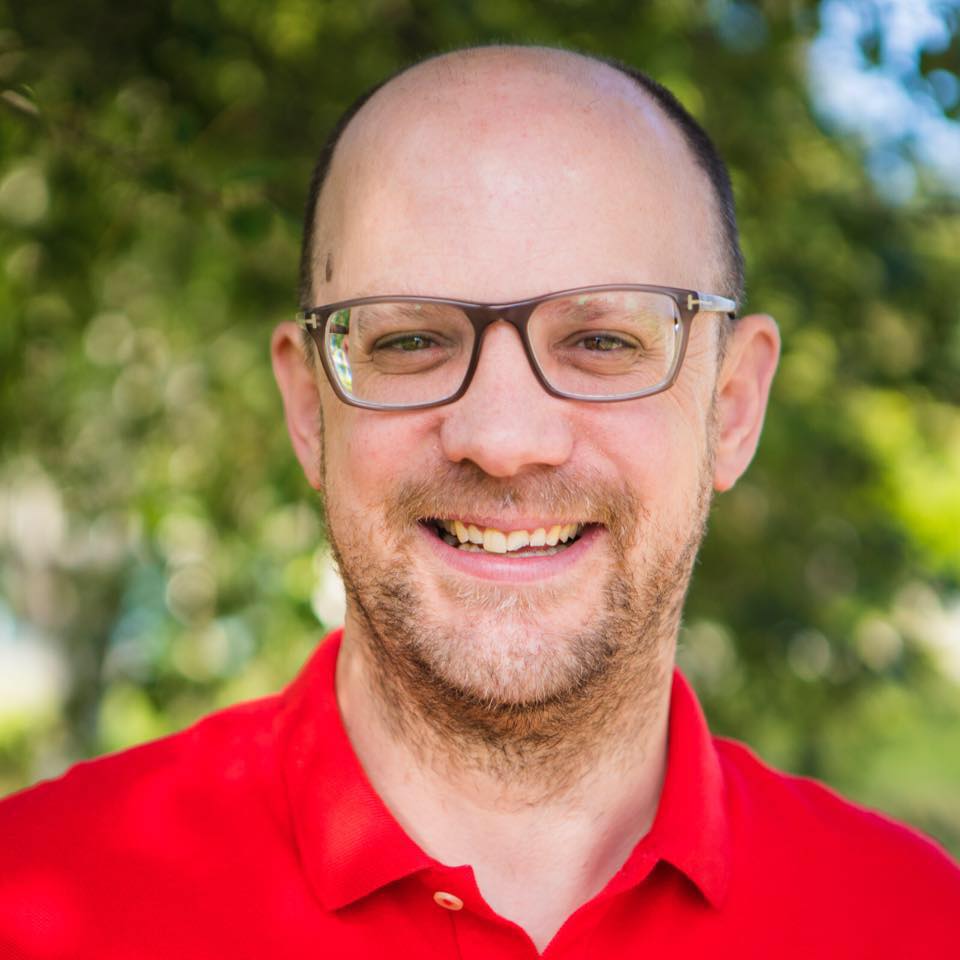
Peter Webley is one of 54 academic inventors honored as Senior Members of the National Academy of inventors for spring 2019. UAF photo by JR Ancheta
The National Academy of Inventors named Webley to its spring 2019 class of senior members. He is the first senior member from Alaska. Senior members are active faculty, scientists and administrators from National Academy of Inventors (NAI) member institutions who have demonstrated remarkable innovation-producing technologies capable of changing society. They also have proven success in patents, licensing and commercialization.
Webley is among 54 academic inventors named NAI senior members this spring. The class represents 32 research universities, government, and nonprofit research institutes. They are inventors named on over 860 U.S. patents. Senior members are elected biannually, and nominations are accepted on a rolling basis. A full list of NAI senior members is available at https://academyofinventors.org/.
NAI is a member organization comprising U.S. and international universities, and governmental and non-profit research institutes, with over 4,000 individual inventor members and Fellows spanning more than 250 institutions worldwide. It was founded in 2010 to recognize and encourage inventors with patents issued from the U.S. Patent and Trademark Office, enhance the visibility of academic technology and innovation, encourage the disclosure of intellectual property, educate and mentor innovative students, and translate the inventions of its members to benefit society. The NAI publishes the multidisciplinary journal, Technology & Innovation. https://academyofinventors.org.
For more information on the NAI and UAF’s involvement, please contact Faculty Ambassador Webley at pwwebley@alaska.edu
Hoodillow AIC 2018 winning team's advice. Video provided by UAF School of Management.
The Arctic Innovation Competition (AIC) provided an update on the winners of the 2018 Student Kicker and Fan Favorite Awards. This team of UAF students met at the 2018 Fairbanks Startup Weekend, taking home first place that lead to a pitch at AIC 2018.
Reminder: Are you feeling inspired yet? Enter your AIC idea today!
The AIC 2019 idea submission deadline is Friday, September 20, 2019.
Questions? Contact AIC at aic@arcticinno.com or call (907) 474-6518. The UAF Arctic Innovation Competition is 100% donor funded.

The University of Alaska (UA) Community Challenge, known as the Alaska Community Challenge, is open for ideas and for teams to connect to project leads. Find out more at Center ICE website.
The team from 2018 – 2019, Avy Pouch, that went on to win the 2019 IDEAs award for best student/postdoctoral invention disclosure, has some updates. Inventor and entrepreneur, Ray Huot, who worked directly with the student team states that the first prototypes of the Avy Pouch design shipped from the manufacturer last month. Great News!

Technological advancements will change the future of education in Alaska and around the globe. The UAF Chancellor’s Innovation in Technology and E-learning (CITE) Program Fellows is a program that recruits, prepares, and supports dedicated teaching faculty who are interested in pushing the boundaries of innovative thought, practice, and action in education through incorporating technology in new ways.
CITE Fellows nominations open for the 2019-2020 cohort until September 12, 2019. More information and nomination form is available at CITE Fellows website

Bristol Bay Development Fund is rolling out a new program called Path to Prosperity – a business education boot camp and business plan competition with awards for 3 winning business plans. The top two winning plans will receive up to $20,000 and the third winning plan will receive up to $10,000. The grant awards can support the small business ideas with technical assistance, marketing, or other capacity building activities identified in the business plan.
Path to Prosperity is comprised of two rounds. Round 1: Interested applicants complete an online or paper application and sign a Release Agreement. Round 2: 10-12 finalists from Round 1 will attend a 3-day business education boot camp hosted in region on November 15-17. Finalists will receive in-depth business education and guidance for business plan writing from experienced mentors, attend workshops, and network with other finalists. Participants will leave with a circle of support and access to business advising to finish their business plans.
Applications are due September 15. For an Informational Flyer about the program, click HERE For official rules and application, click HERE.

Another cohort for UA’s I-Corps program is forming, so do not miss out. The National Science Foundation’s Innovation Corps offers up to $2500 from a federally funded program to accelerate STEM projects for both University and non-University teams toward commercialization and validation of their ideas.
Learn more here, and contact Nigel.Sharp@alaska.edu for more information.
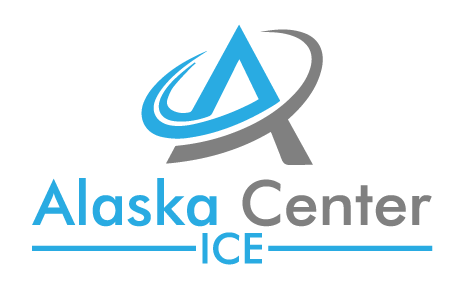
The Center ICE Seed Fund awarded 8 grants, from $5,000 to $25,000, in the all of 2018 to University and community innovators working on commercialization or technical challenges that needed a "nudge" to make some critical progress.
The Center ICE Seed Fund is accepting additional proposals for consideration for fall 2019 awards. Visit https://www.uaf.edu/centerice/seed-funding/ for more information and to apply.
As the new academic year kicks off, OIPC is ready to work with you and your inventions. Come talk to anyone from the office or give us a call at 907.474.2605
After you disclose your technology, an OIPC representative will follow up with you to talk more about the innovation, OIPC will perform a marketability and patentability evaluation, the Intellectual Property Advisory Committee will review and recommend whether to pursue IP protection, and then OIPC will work to market and license the technology.
All inventions disclosed during the 2019 – 2020 academic year will then be eligible for the 2020 Innovative Disclosures and Entrepreneurial Activities (IDEAs) awards. Found out more on the 2019 winners at https://uaf.edu/oipc/inventors/ideas/index.php
For more information on disclosing your invention with OIPC, please go to https://uaf.edu/oipc/disclosure/ or email us at uaf-oipc@alaska.edu
August
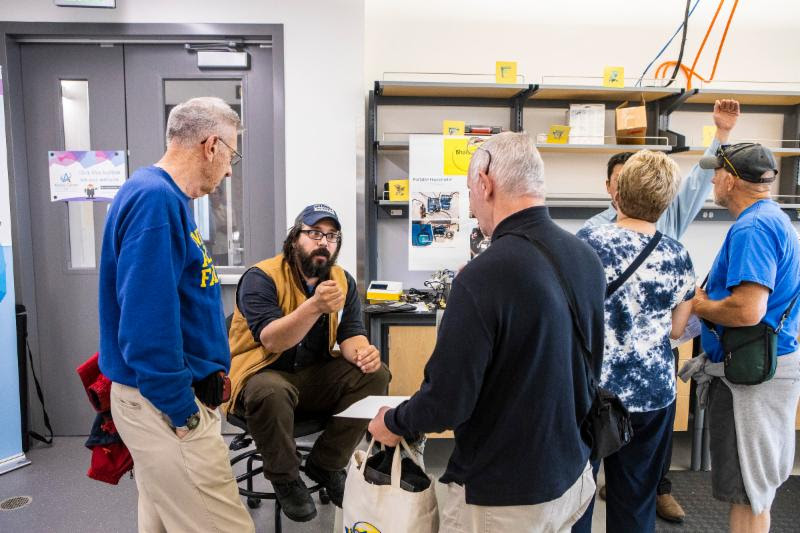
Alumni and community members discussing UAF inventions with faculty, staff, students, and startup companies during the July 19, 2019 OIPC and Center ICE Open House. Photo by JR Ancheta.
On July 19th, UAF OIPC and Center ICE held an Open House for the Nanook Rendezvous. Here, UAF's Alumni met innovative UAF faculty, staff, and students and discovered the entrepreneurial activities and programs provided by OIPC and Center ICE.
They heard from the companies established from University research and were able to talk to the owners as well as meet the students working in these startup organizations through the Students2Startups program at UAF.
Several of the winners of the top invention disclosures of the past academic year (IDEAs awards) were available to talk to those attending the Open house while the alumni were able to appreciate first-hand how UAF is building a pipeline to foster University innovations and transfer them into the commercial market to drive economic growth for Fairbanks, the Interior, and the State.
For more information on the IDEAs awards contact Peter Webley at pwwebley@alaska.edu and the student2startups program contacts Erik Talvi at etalvi@alaska.edu or Center ICE at centerice@alaska.edu.
UAF Hacking for Defense - Wave Power for the Alaskan Coast.
Robert Coker, Ph.D. and Brandon Kowalski (Teaching Assistant) delivered the first course in Hacking for Defense (H4D) at the University of Alaska Fairbanks this summer. In this particular case, "hacking" reflects an expeditious, iterative process of finding solutions for the U.S. Department of Defense and the intelligence community.
The UAF students were originally focused on developing new alternatives for energy capacity in unmanned, undersea vehicles (UUVs) in wild, remote settings like Alaska. 'Beneficiary discovery' or talking to individuals through interviews who live in this world is a central theme of H4D. From there, concepts are developed that closely match the needs of beneficiaries to potential products or prototypes. The early stages of this process work towards the agile development of a minimal viable product (MVP) that might begin to solve the existing "pains" of energy delivery in our particular case.
Over an accelerated pace of six weeks, UAF students with backgrounds in communication, homeland security, and engineering focused on the problems of the beneficiaries. Through these interviews, it was established that marine scientists gathering data using these devices were also limited in their capacity to acquire data due to lack of energy. UUVs that run out of electrical power would surface and remain dysfunctional for months before retrieval. Remarkably, these groups were not likely to consider alternatives to due difficulties with deployment. The majority of beneficiary interest centered around coastal communities in Alaska using wave generated energy for commercial fishing and overall sustainability. It was also discovered that these beneficiaries could serve as a testing ground for energy provisions due to adequate policies in place from a regulatory standpoint.
Beneficiary discovery during H4D provided the students with an opportunity to determine what strategies/products/services in the form of an MVP might mitigate the biggest pains. Central to all groups working with wave generated electrical power, the students developed MVP linked managing entities and point of contact information with the licensing/regulatory process and sources of funding to enable deployment in remote settings. Developers and beneficiaries will now have one stop access to comprehensive information that will increase the speed and agility in this sector of important energy development.
The team thanks all of their beneficiaries for their important role in this process. Larry Bartlett of Pristine Ventures served as an extremely valuable mentor who kept students grounded in beneficiary discovery. The students also expressed our sincere appreciation to the late Dr. Edward "Ted" Cape of Direct Action Networks International for providing mentorship in the intelligence, security and reconnaissance domain for our students. We all offer our since condolences to his friends and family.
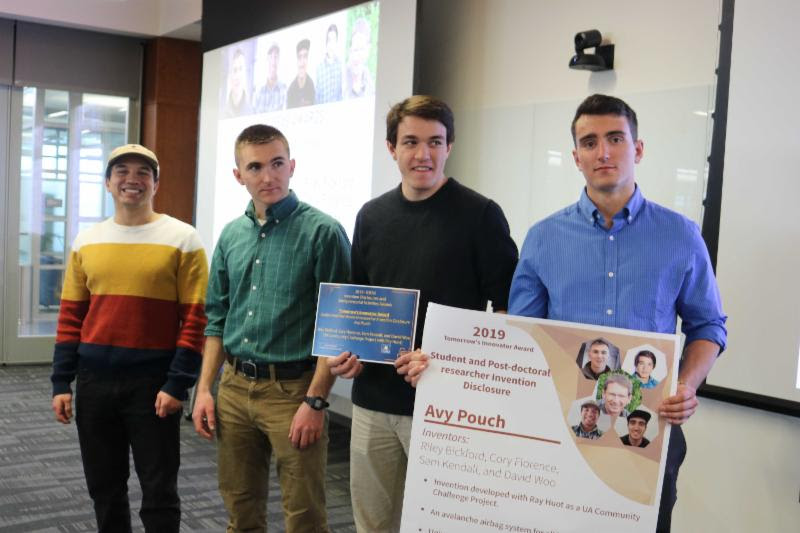
Tomorrow's Innovator Award winners for Top Young Innovator(s). The Avy Pouch team, a UA Community Challenge Project. Cory Florence, Riley Bickford, David Woo, and Sam Kendall. Photo by Amanda Byrd.
Looking back over the past year (July 1, 2018 - June 30, 2019), we see that 28 invention disclosures were made to OIPC, with 24 from UAF innovative faculty, staff, and students and 4 additional disclosures from researchers at UAS. Of the total 28, 14 were led by Faculty, 10 by staff members, and 4 had a student(s) leading the invention.
The invention disclosures were from across the research, teaching, and service activities of UAF and UAS faculty, staff, and students. Several disclosures focused on health impacts while others centered on research tool development, safety, energy, ocean economy, and transportation.
These disclosures highlighted the breadth of inventions from UAF and UAS and how everyone is cultivating new ideas to transition them into technologies and opportunities for business development as well as build solutions for the challenges of Fairbanks, Alaska, and across the Arctic.
For more information on disclosing your invention with OIPC, please go to https://uaf.edu/oipc/disclosure/ or email us at uaf-oipc@alaska.edu.

The Technology Research and Development Center of Alaska (TREND) funded by the Alaska Small Business Development Center, has a central mission to assist Alaska's small businesses and entrepreneurs in commercializing their technology and assist Alaska businesses to compete and win federal research and development grants. TREND offers cash awards and proposal writing assistance to develop SBIR grant applications.
TREND will award funding up to $10,000 in cash and services to each of four entries in September 2019 for entries submitted by August 15, 2019.
Let TREND help you be successful on your next Phase 1 SBIR proposal.
Visit for more information.

Angie Mendbayar stands in front of a Box Power solar panel. Photo courtesy of BoxPower.
The first thing you notice when speaking with Uyanga "Angie" Mendbayar is her passion for making the world a better place. She holds a high value in equal access to energy, especially renewable energy. And, that is something she is doing through an internship with a startup company, BoxPower.
Angie was born and raised in Erdenet city in Orkhon Province, Mongolia. Erdenet is a sister city to Fairbanks, Alaska, and like Fairbanks it was founded through mining. Copper deposits were found in the 1950s, and in 1974 Erdenet was born. Until the fall of Soviet Communism, more than 50% of the community's inhabitants were Russian miners and engineers. Now, the community that hosts the 4th largest copper mine in the world is home to almost 98,000 people, the 3rd largest city in Mongolia, with 8,000 people employed by the mine.
After Angie graduated high school, she discovered the one-time opportunity of UAF Presidential Tuition Waivers made available to two students from Erdenet through the sister city relationship. The majors for this scholarship were predetermined, and another student in her class quickly chose the mining engineering degree. Hence, Angie applied for the geological engineering scholarship. What she didn't realize was that traveling all the way from Mongolia to Fairbanks would land her looking at rocks for over three hours a day in her geology labs.
During her junior year at UAF, Angie sustained a traumatic brain injury and partial vision and hearing loss from a near-death car accident in Fairbanks. This wake-up call caused Angie to reevaluate her goals and passions in life. When she went back to college, she got more serious in her studies. She got involved in National Science Foundation (NSF) funded research projects and was awarded a grant to lead a research project in investigating an Arctic and sub-Arctic engineering challenge related to climate change. Soon after her graduation in May 2015, Angie started getting involved in activism and campaigns for climate change and renewable energy.
With a renewed focus, Angie enrolled in the Occupational Endorsement in Sustainable Energy program through UAF Bristol Bay Campus. During her first class in the program, Angelo Campus, founder/CEO of California-based startup-BoxPower presented to the class about the 2018 deployment of their containerized, pre-fabricated solar energy systems in Buckland, Alaska. Angie felt an instant connection to their product as a solution to many remote communities.
Angie kept in touch with Mr. Campus and when the Center ICE Students2Startups (S2S) program was launched, Campus saw the opportunity to hire Angie as a student intern. She works remotely from Juneau, and it's challenging to not have an in-person teamwork environment. However, she is happy to be doing work to directly reduce emissions in Alaska and enhance energy independence. She is also enjoying working for a startup company, the support from Center ICE staff, and the network of the other S2S interns.
"Students2Startups is very exciting, and I'm happy to see students get real-life experience in the workforce. It is amazing to get experience in a startup," Angie Mendbayar said. "There are many startups, and a lot of them fail - they don't get out of the research stage."
Angie is also part of the second NSF I-Corps cohort led by Center ICE manager, Nigel Sharp. I-Corps bridges the gap between academic research and customer needs. Through her internship and I-corps participation, Angie is exploring customer and market needs in order to customize the academic research and technology to those needs. That is helping to guide BoxPower's market discovery.
BoxPower has four other interns from Princeton University. One of them is working on customer discovery, and he is Angie's teammate for the I-corps program. They are exploring companies with high-energy costs that include tourism, fisheries, mining, and oil and gas companies. However, most of them are not Alaskan companies. Angie and BoxPower want to help Alaskan companies and the new I-Corps team will be working to strategize their market discovery for the chosen market.
The S2S program has regular student check-in conference calls and during the last one, the students were asked about their challenges and internship work updates.
One thing Nigel stressed to the students was to be bold, to ask the hard questions. Ask, "Why am I doing this?" "How does this support the goals of the startup?" "Am I just doing busy, engineering work?" The goal of S2S interns is not to just be doing engineering, it is to be gaining actual startup company experience.
Angie has some advice for all future student interns. "I really want any student to question their goals. Ask yourself what will bring you happiness. Is it what society says brings people happiness - like a degree, successful career, or a large salary. And, really question that goal while working with a startup - is your work making an impact for the startup or the customers? Or, is it just busy work?"
Angie doesn't have a business idea of her own, yet. Right now, she is happy to be a part of the startup process with BoxPower. She knows she will make mistakes, and she does not want her mistakes to hurt the startup - she believes in BoxPower and wants to see it succeed. And, she would like to see other sustainable energy projects succeed, bringing energy access to more people, and eventually take the successful renewable systems to her home country of Mongolia.

Center ICE is courting applicants for Cohort 3 (currently one space remains) of the NSF i-Corps program (kickoff is Mid-August), which offers up to $2500 in travel grants/conference fees to accelerate STEM projects from both University and Non-University teams toward commercialization. Learn more here. And apply by contacting nigel.sharp@alaska.edu.

Alaska Senator Lisa Murkowski, along with Senator Chris Van Holland (D-Md) and U-S Representative Bill Foster (D-Ill), recently introduced the 'National Fab Lab Network Act" legislation to expand Fab Labs across the country. Read more here.

Launch Alaska is accepting applications for their fall Tech Deployment Track accelerator. Topics for new program include world-changing technologies in water, food, energy, and transportation. Find more information and apply at https://www.launchalaska.com/.
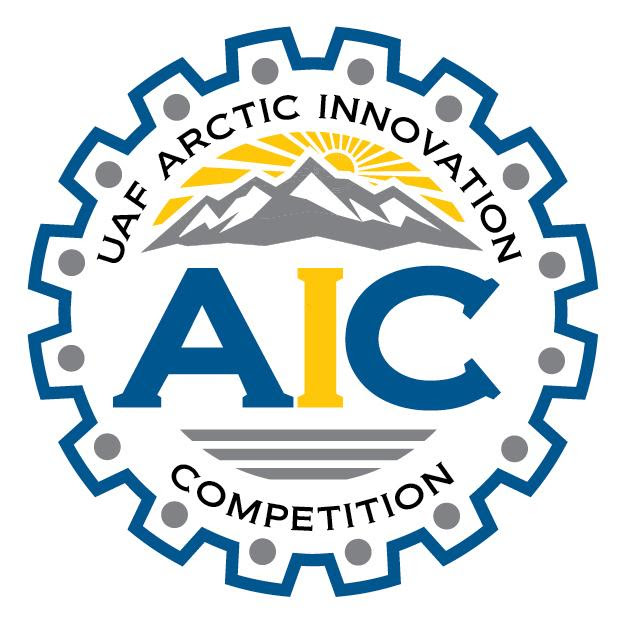
The 2019 Arctic Innovation Competition, hosted by the UAF School of Management, is open and accepting submissions. The competition awards $30,000 in cash prizes for original ideas.
All ages are welcome, there is no fee to enter, and applicants do not require a fully developed product or a business plan. Find out more about the competition at https://sites.google.com/alaska.edu/uaf-aic/home.
July
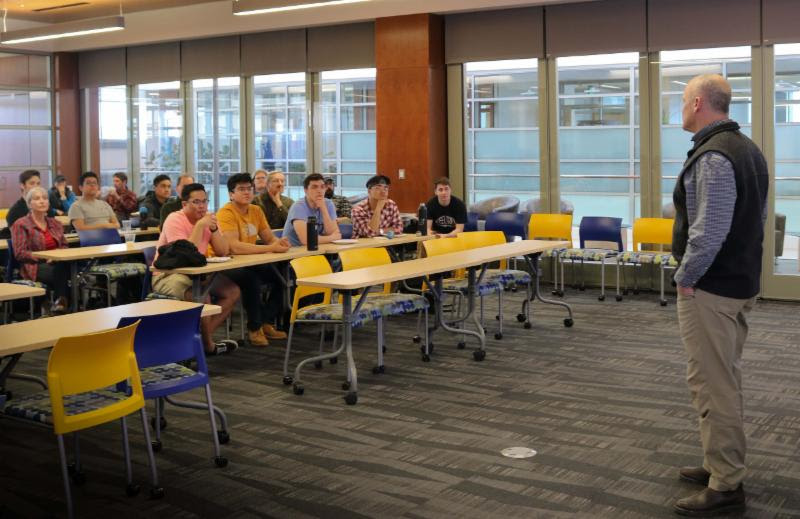
Dr. Robert Coker describes his hacking for Defense class during the IDEAs Awards. Photo courtesy of Amanda Byrd.
As we prepare for another great academic year, let's take a moment to reflect on the incredible year that has passed. Over the past twelve months, OIPC staff, students, and faculty members - along with a multitude of partners - have worked tirelessly to advance university research through industry partnerships and to build a culture of innovation and entrepreneurship.
The year kicked off with the federal SBIR/STTR Road Tour in July 2018. The Small Business Innovation Research and The Small Business Technology Transfer programs have been called the U.S.'s largest seed fund, and Governor Walker welcomed the tour. Small business and university innovators networked and had the unique opportunity to meet individually with federal program managers to learn how to best align their companies and innovations with federal priorities. Numerous UAF researchers have been awarded the highly competitive SBIR/STTR grants including biomedical engineer Bahareh Barati.
The Innovation Initiative (I2) continued with many successful innovators and entrepreneurs discussing their process of developing an idea into a successful business, whether it be groundbreaking medical technologies, tools to improve scientific data collection or a travel pillow that lets you sleep in private.
OIPC hosted TechStars Startup Weekend in Fairbanks in September 2018 where, in 54 hours, ideas were pitched, teams formed, and successful entrepreneurial ventures tested. The weekend's winners, Hoodillow, spent their 54 hours interviewing anticipated customers, building prototypes, and developing business models and their win scored them an entry into the Arctic Innovation Competition.
Hacking events featured across campus. The term 'hacking' is to used describe the rapid, iterative process of problem-solving, and student and staff-led events included UAF Cybersecurity Club's hackathon during Fairbanks Startup Week, November 2018, and the new UAF course Hacking for Defense (HD4i) was launched by OIPC ambassador and UAF faculty and entrepreneur Robert Coker in early summer 2019.
Fairbanks TechStars Alaska Startup Week was co-led by OIPC ambassador Peter Webley and Fairbanks Economic Development Corporation's emerging Arctic, technology-led development project manager Juliet Shepherd. Events were held across campus and the community including Girls Who Code - Creating the Future event at Noel Wien Library, Introduction to Rural Airbnb - for tribal members and rural entrepreneurs at David Salmon Tribal Hall, and a meet and greet with a patent attorney on the UAF campus.
The first Alaska Center ICE Community Challenge project was completed by a team of UAF senior engineering students. The challenge was submitted by a private company that creates lifesaving avalanche survival devices. The team won the Top Young Innovator award during the first annual IDEAs Award ceremony.
The first annual Innovative Disclosures and Entrepreneurial Activities (IDEAs) Awards were held in conjunction with World Intellectual Property Day in April 2019. The IDEAs Awards recognize UAF and UAS faculty, staff, and students who have developed and disclosed innovative approaches to research, teaching, and service. The Top Overall award was won by Tom Marsik, Riley Bickford, and Rorik Peterson for their Arctic Dual Hood for Heat Recovery Ventilation product.
The Center ICE Seed Fund awarded eight grants, $5,000 to $25,000, in the fall of 2018 to UA and community innovators working on commercialization or technical challenges that needed a "nudge" to make some critical progress.
The first Students2Startups event successfully brought together 25 students and 9 startup companies, resulting in summer internships in areas including engineering, biomedical, and more.
UAF faculty, staff, and students pursued new startup companies, OIPC recorded 28 new technology disclosures, and UAF licensed more technologies. New licenses include C. elegans Sieve, OCD Mouse Model and methods, Heating control system for Arctic engines, and Piano Ligh
Thank you for all your help over the past year and for your contributions to innovation and entrepreneurialism in Alaska. Now, let's roll up our sleeves and make the next year our best yet!
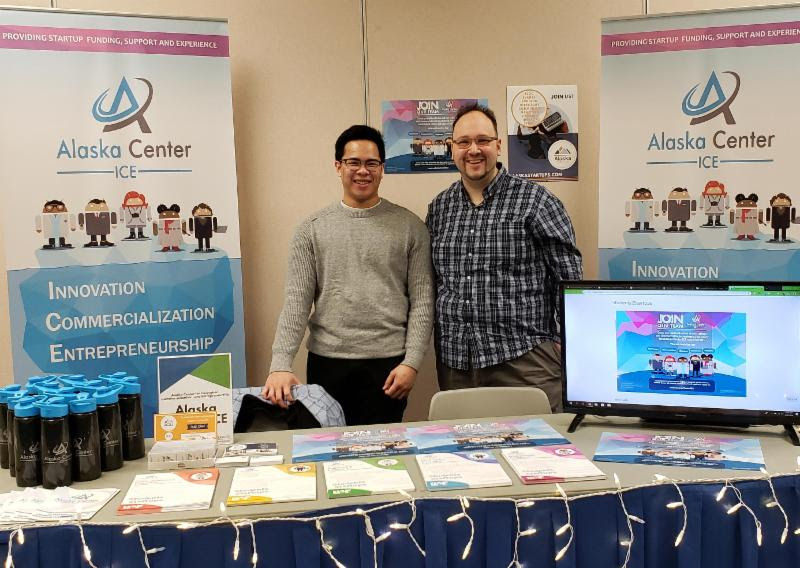
Nigel Sharp and Kernell Snow met potential interns at the UAF Spring Internship Fair. Photo courtesy of Nigel Sharp.
As part of the upcoming Nanook Rendezvous Alumni Reunion, OIPC and Center ICE will host an open house on July 19th on the fourth floor of the Engineering Learning and Innovation Facility. The event will introduce our innovative faculty, staff, and students at UAF and showcase our entrepreneurial activities and programs.
Visit us from 2 to 4 pm to learn more about companies established through University research and meet the students working in these startup organizations. Learn more about the top invention disclosures of the past academic year and how UAF is building a pipeline to foster University innovations and transfer them into the commercial market to drive economic growth for Fairbanks, the Interior, and the State.
For more information contact Alexis Rhynard at aarhynard2@alaska.edu and Peter Webley at pwwebley@alaska.edu.
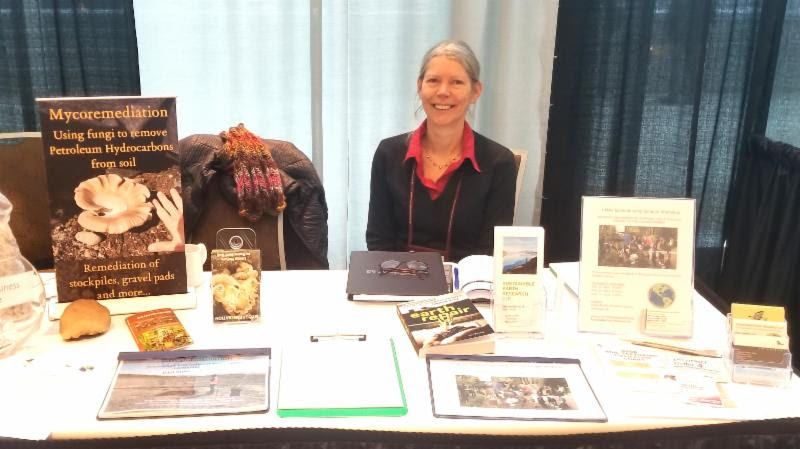
The Alaska Community Challenge team, Avy Pouch was featured at the OIPC booth during the open house.
The second cohort for the 2019 National Science Foundation supported I-Corps experience is kicking off on June 28th.
I-Corps is a highly-experiential, approximately 6-week-long program. Each team will receive $2,500 from an NSF grant for their participation in the program. Participants are expected to dedicate an average of three hours per week to the program activities and requirements.
At the end of the session, participants will have an understanding of their customer needs and the marketability of their project. Participants are required to have 20 quality interviews with potential customers and industry experts. This is one of the best first steps to take on the path of entrepreneurship. The experience will be led by Nigel Sharp, a national NSF I-Corps alumni, and the Center ICE startup and innovations manager, contact at nigel.sharp@alaska.edu.
Application Due Date: ASAP as space available
What: I-Corps Cohort 2
When: June 28th
Where: Center ICE and Virtual
Who: Anyone working on a project in STEM
Why: $2,500 grant funding for market discovery / travel
More Info: www.uaf.edu/centerice/customer-discovery/
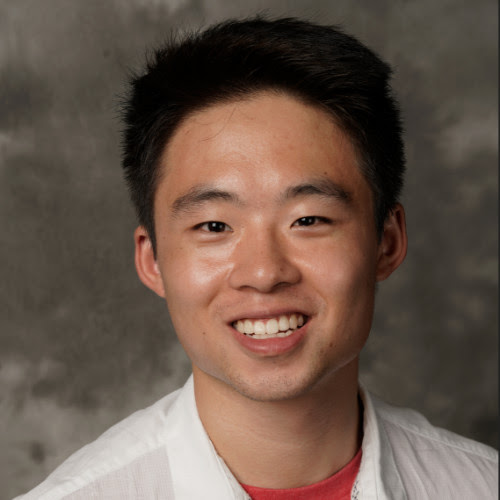
Richard Chen graduated from UAF in 2018 and is now a graduate student at Duke University.
When Richard Chen graduated from UAF in spring 2018 with a bachelor of science in mechanical engineering with a minor in biology, he had already charted his course toward disruptive medical technology. He was one of the first students to enroll in the Lean Launch course led by Steve Weinstein and Nigel Sharp (Entrepreneur in Residence - Alaska) at UAF and learned the value of the business model canvas and customer discovery. Working alongside other students and faculty, his team explored the implementation of a climate resistant drug container system.
As an undergraduate, Richard worked in Robert Coker's laboratory on several projects. In one project, he was an important co-author on a manuscript published in Frontiers in Physiology that described the importance of cytokines relevant to skeletal muscle preservation during arduous field operations. This work will also be featured in an upcoming issue of Popular Science. He has other co-authorships on manuscripts in progress related to clinical nutrition.
Hungry for a challenge, Richard was selected as an undergraduate National Aeronautics and Space Administration (NASA) intern to work on a project titled "The Role of Depressed Metabolism in Radiation Damage Prevention" at Ames Research Center in Moffett Field, CA. During this experience, he worked under the guidance of skilled mentors and engaged in authentic NASA-related, mission-based R&D and career-related activities. The Coker Lab calls him their 'Astronaut'.
While Richard knew that his energy was directed at biomedical engineering with an innovative spin, he applied to several graduate programs.
Coker recalls Richard's excitement when he was selected at Duke University along with several other schools as "I knew I should be pretty competitive but I am a bit overwhelmed with all of these opportunities". We were not surprised.
Richard chose Duke University because their program seemed to provide the best conduit towards his lifelong aspirations and they have a really good basketball team. Since his arrival, he has developed a computer program complete with load sensors and visual feedback mechanisms for patients with cerebral palsy to mitigate excessive muscle tightening. He is also part of a five-person team working on better electronic visualization for chest tube insertion in trauma patients. Without better technology, the emergent nature of the procedure may result in tissue damage and the status of the patient could deteriorate rapidly.
Richard has always been fascinated by science only to learn that he can now make amazing contributions to healthcare and scientific exploration. With the undergraduate research experiences steeped in innovation at UAF, his mind and hands are now actively engaged across the spectrum from market size to idea generation to U.S. Food and Drug Administration approval to clinical practice. We are proud to call him a Nanook!

OIPC is moving its technology listings to the iBridgesystem where the world can browse the technologies UAF and other universities have available and where people can quench technology needs.
iBridge is a place to discover other researchers' technologies for future collaborations. The iBridge system offers cutting-edge, emerging technologies from the world's most influential technology institutions.
Over 180 U.S. academic institutions and funding agencies including the National Science Foundation and the National Institutes of Health, Center for Translational Science Awardsuse the platform to showcase their early-stage technologies and technology professionals.
Please share your ideas and suggestions about how UAF can best use the system to help you share your needs or promote your work. For more information contact Ky Holland at hrholland@alaska.edu.

Screenshot of the first cohort of Student2Startups interns meeting via an online coffee break chat. Photo by Erik Talvi.
Students2Startups is off and rolling. The seven interns from across Alaska met during our first introductory meeting. Two students from the Alaska Space Grant Program joined the meeting.
Over the rest of the summer, the interns will work with their startups, while also networking with each other to learn about how diverse startups can be.
S2S Interns will also be helping to create a community within Center ICE. The interns will be working to define the community aspects of the Center ICE space.
Keep an eye out as the space develops! Come meet them at the OIPC open house on July 19th.
For more information on Students2Startups contact Erik Talvi at etalvi@alaska.edu.

The Alaska Center ICE Community Challenge program curates problems from industry and matches them with faculty, staff, and student expertise.
Students: Looking for a project topic for one of your classes?
Faculty: Looking for projects for your students?
Alaska community members: Have a real-world problem that that college students might be able to help with?
For more information, to submit your challenge, or to check out a list of current challenges, visit: Center ICE website, contact hrholland@alaska.edu or call (907)-727-2735.

Launch Alaska is accepting applications for their fall Tech Deployment Track accelerator. Topics for new program include world-changing technologies in water, food, energy, and transportation. Find more information and apply at www.launchalaska.com.

The 2019 Arctic Innovation Competition, hosted by the UAF School of Management, is open and accepting submissions. The competition awards $30,000 in cash prizes for original ideas.
All ages are welcome, there is no fee to enter, and applicants do not require a fully developed product or a business plan. Find out more about the competition at https://sites.google.com/alaska.edu/uaf-aic/home.
Many government contracts and grants require an "adequate" or "approved" accounting system. Learn the essential components of an accounting system and best practices for passing the SF 1408 survey. Approved accounting systems are required for Small Business Innovation Research (SBIR) Phase II, time-and-materials (T&M) contracts, cost-reimbursable contracts, and multiple-award and government-wide acquisition contracts.
A webcast at 9 am Alaska time on July 18, 2019 will be offered to Alaska registered PTACclients only to guide you through the basic requirements. Email jysummers@alaska.edu for registration site and access code.
June

Dr. Robert Coker teaches the first Hacking for Defense course at UAF. Photo courtesy of Robert Coker.
The first course in Hacking for Defense is up and running at UAF.
Unlike computer hacking, we use the term ‘hacking’ to describe the rapid, iterative process of problem-solving for the U.S. Department of Defense and Intelligence community.
Sourced with a real problem specifically curated for Alaska by H4Di, our team of students has been focused on developing new alternatives for energy capacity in unmanned undersea vehicles (UUVs) that are typically used to gather data in remote settings. While some might think that this would mean the generation of various prototypes, the H4Di strategy utilizes beneficiary discovery as the foundation of their solution-driven strategy.
Over the past two weeks, students with backgrounds in communication, homeland security, and engineering have focused on the “pains” of the beneficiaries and found out that many issues related to adequate energy to drive UUV’s are shared across disciplines. For example, marine scientists gathering data using these devices are also limited in their capacity to acquire data due to lack of energy. Due to lack of adequate energy, UUVs may go “belly up” and dysfunctional for months before retrieval.
Now that our UAF team of students has been acquiring specific information from beneficiaries, they are working through a “Value Proposition Canvas” to determine what strategies/products/services in the form of a minimal viable product might address the needs of their beneficiaries. In this way, any potential solution will be based on a deep understanding of the real problem well suited to function regardless of water temperature, ocean currents or deployment paradigm.
There are only three fast-paced weeks of work to go before the team gives their final presentation. See next month's newsletter for the identified solutions.
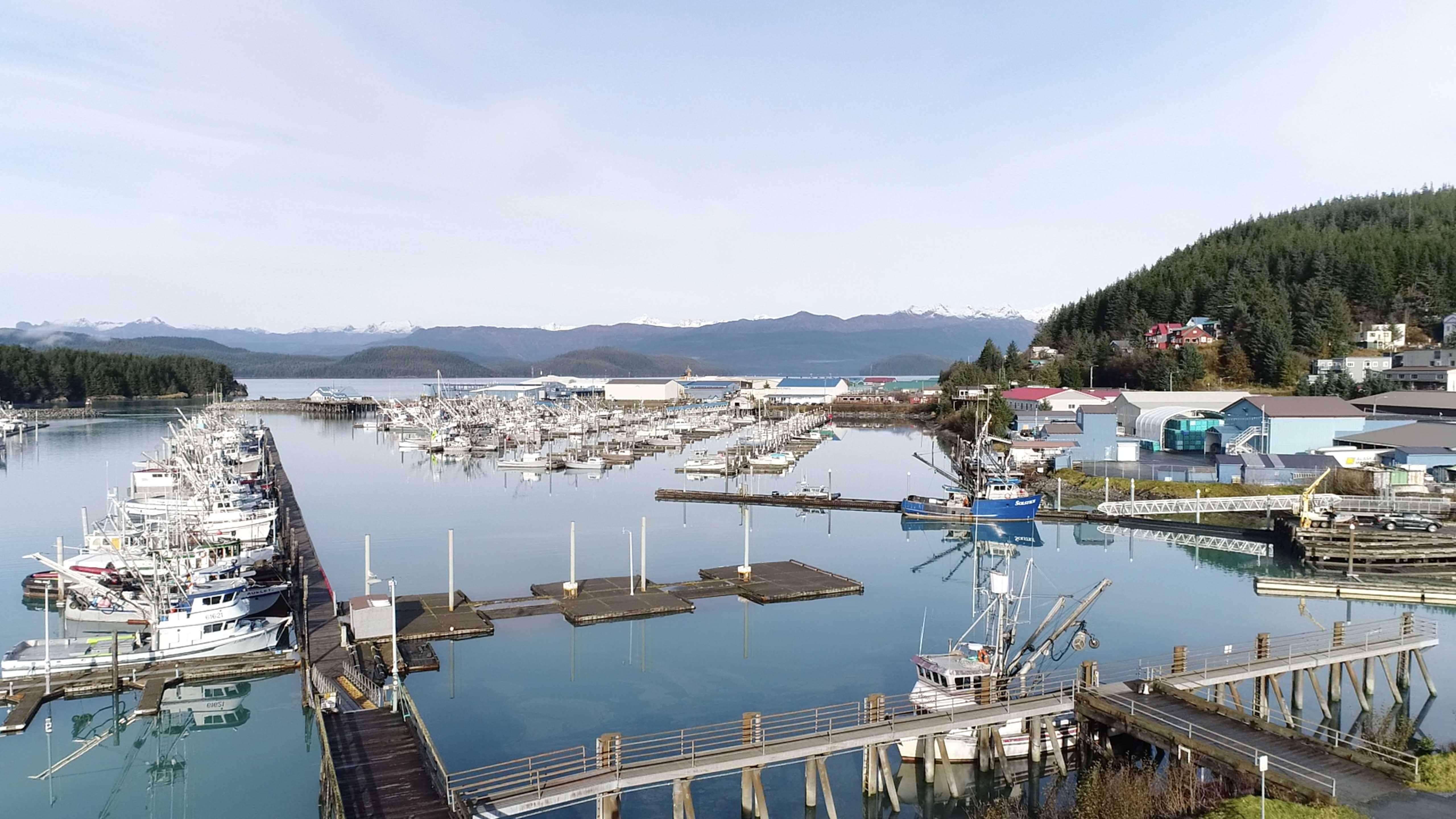
Cordova’s fishing industry is a major player in Alaska’s blue economy. Photo by Amanda Byrd.
The UAF Alaska Blue Economy Center (ABEC) was recently established to help advance new research, education, and economic opportunities for Alaska. An Alaska Journal of Commerce article celebrated the new center’s launch.
The “blue economy” signifies the sector of the economy centered on marine environments (oceans, rivers, and lakes) that represent the potential for substantial economic growth and opportunity for diversifying Alaska’s economy and workforce. Alaska’s oceans already provide immense value to the state, across the Arctic, and the U.S. through fisheries, tourism, and oil and gas exploration. In addition to the traditional sectors, ABEC is working to catalyze growth in the rapidly expanding fields of ocean technology, renewable energy, and marine biotechnology.
“The Alaska Blue Economy Center is a great point of intersection between the University of Alaska and the maritime industries,” says Mark Billingsley, OIPC’s Intellectual Property and Contracts Director. “OIPC and Center ICE are eager to facilitate connections between industry and researchers, spur and support innovation, and then shepherd those innovations to successful adoption by industry.”
Alaska, surrounded by oceans, has 46,600 miles of shoreline, more than the Lower 48 states combined. This positions Alaska as a natural leader in the blue economy.
“We're eager to get help build an innovation economy around the maritime industries, an area ripe for expansion in Alaska,” Billingsley added.
The Alaska Community Challenge team, Avy Pouch was featured at the OIPC booth during the open house.
UAF’s Arctic Research Open House highlighted 26 research facilities and institutes from across the University giving attendees hands-on experience of the world-class research at UAF.
During the event, OIPC highlighted the 2019 IDEAS award winners as well as the Alaska Center ICE Community Challenge and H4Di programs while Center ICE focused on the Students2Startups and I-Corps initiatives.
OIPC Faculty Ambassador Dr. Peter Webley and Center ICE Startups and Innovation manager Nigel Sharp were on hand to highlight how UAF is developing solutions to the challenges and needs of Alaskan companies and the community while also supporting innovation and entrepreneurial activities of UAF’s faculty, staff, and students.
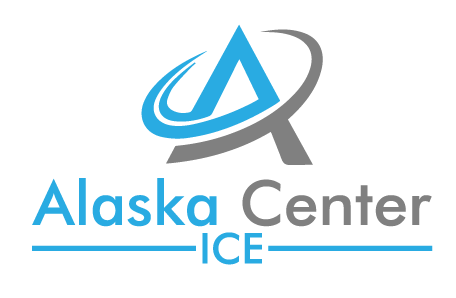 The Center ICE Seed Fund awarded eight grants, from $5,000 to $25,000, in the fall
of 2018 to University and community innovators working on commercialization or technical
challenges that needed a "nudge" to make some critical progress.
The Center ICE Seed Fund awarded eight grants, from $5,000 to $25,000, in the fall
of 2018 to University and community innovators working on commercialization or technical
challenges that needed a "nudge" to make some critical progress.
The Center ICE Seed Fund is accepting additional proposals for consideration for fall 2019 awards. Visit Center ICE for more information and to apply.
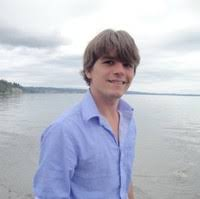
Erik Talvi joins the Center ICE team.
Center ICE is pleased to announce Erik Talvi has joined the team. Eric is a Fairbanks tech entrepreneur and mentor and UAF alum. He started his first web design company while completing his MS in computer science at UAF. Most recently, he was a co-founder of the local computer vision startup, Attently, Inc, and also an alumnus of the Launch Alaska business accelerator. He'll be actively engaging with all Center ICE members and will be at our upcoming events.
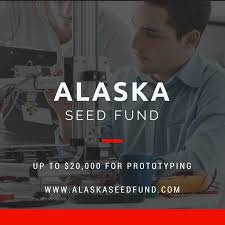 The Alaska Seed Fund awarded ten grants to assist Alaskans with prototyping their
inventions, launching products, and growing companies in the state.
The Alaska Seed Fund awarded ten grants to assist Alaskans with prototyping their
inventions, launching products, and growing companies in the state.
The Fund is a collaboration between the University of Alaska Fairbanks' Office of Intellectual Property and Commercialization (UAF OIPC), and the Alaska Small Business Development Center (AK SBDC) at the University of Alaska Anchorage Business Enterprise Institute.
From the 41 applications received, two main prizes and eight additional prizes were awarded to successful startups.
The grand prize of $20,000 went to The Launch Company, who understands the needs of New Space rocket companies that require high-quality semi-custom fittings to meet the tight schedule and budget needs of lean space startups.
Aquagga sH20, whose technology tackles sanitation and desalination challenges faced by a third of the world's population, including many Alaskans, with an affordable, modern, durable three-dimensional printed solution, was awarded the second place prize of $10,000.
The following companies shared the remaining $20,000 awards: Legalverse, Ramper Innovations, The Fungi Alliance, Gennaker Systems, Omega Grid, RestAngles, Alpine Fit, and Threat Informant.
Congratulations to all awardees, and thank you to Wells Fargo and the 49th State Angel Fund for their contributions to the Alaska Seed Fund. Stay tuned for the next round of the Alaska Seed Fund. For more information, visit Alaska Seed Fund.
May
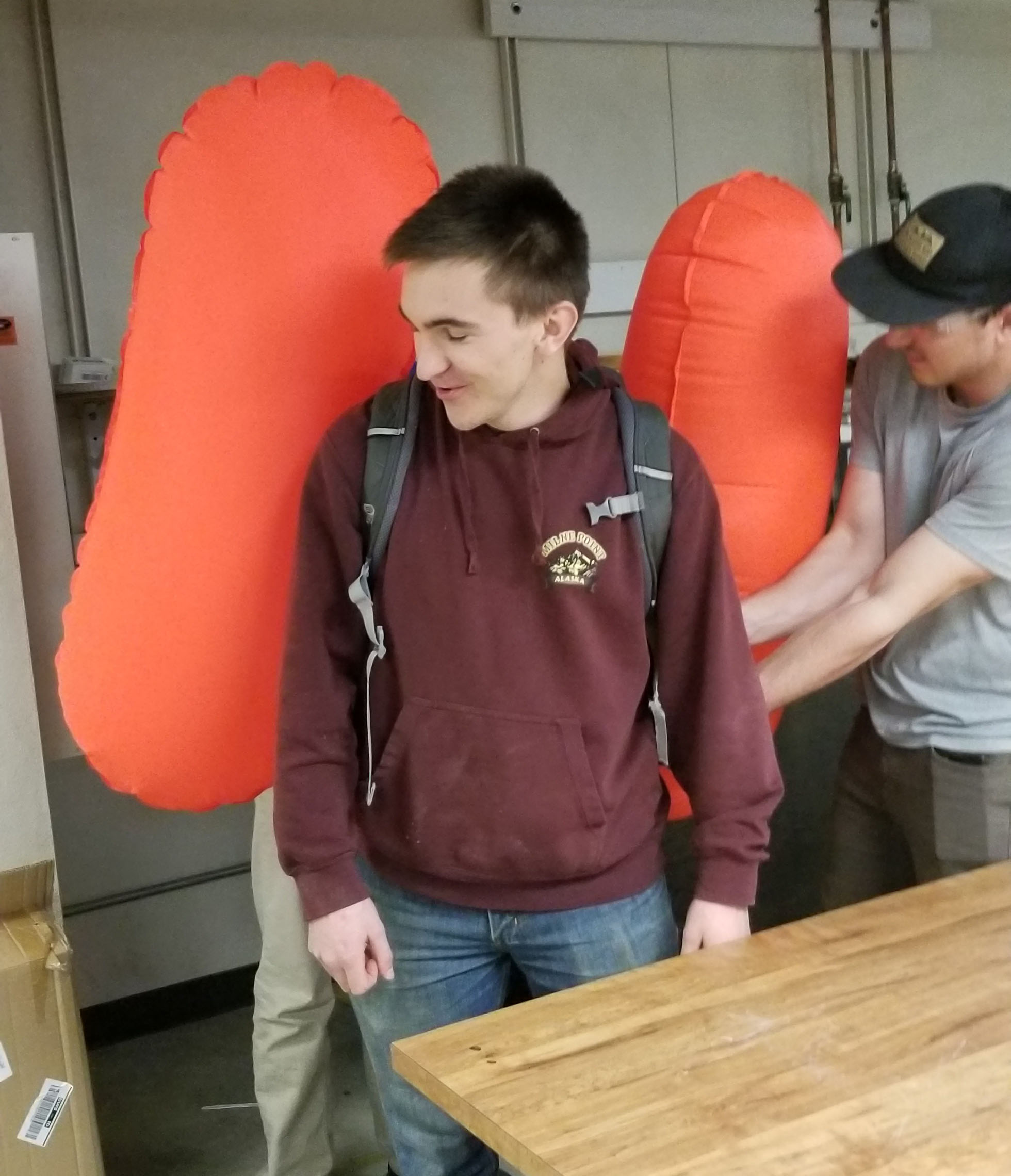
The Avy Pouch community challenge brought private industry and engineering students together. Photo by Cory Florence.
Efforts to move a university innovation to the market are more successful when performed in an environment that is designed to foster innovation. A recent UAF project demonstrates the sequential layers of support offered by the University of Alaska.
Last Fall, OIPC’s Mark Billingsley talked to UAF senior capstone design mechanical engineering students about the Alaska Center ICE Community Challenge, which curates industry problems and tries to match them with UA faculty, staff, and students.
Students Riley Bickford, Cory Florence, Sam Kendall, and David Woo took up the challenge and worked with OIPC’s Ky Holland to connect with industry partner and Alaskan Ray Huot. The “Avy Pouch” senior design project was born.
Using Huot’s patent-pending concept, the students designed and produced a working prototype of an avalanche airbag system that attaches to any backpack.
Huot and the mechanical engineering students applied for a Center ICE Seed Fund, which was awarded to support research and prototype development. One of the award conditions was participation in UA’s NSF I-Corps program, requiring the team to better understand the problem that their anticipated customers face.
Throughout the process, Holland provided mentorship relating to innovation development and steering toward market viability.
The students worked with OIPC staff to disclose their technology to UAF. Ultimately, the team won the Innovative Disclosures and Entrepreneurial Activities (IDEA) Tomorrow’s Innovator Award for best student innovation at UAF and UAS.
Moving forward, Huot and the team are eligible for continued support through the Center ICE Students2Startups intern program as well as prototyping support through the Alaska Seed Fund.
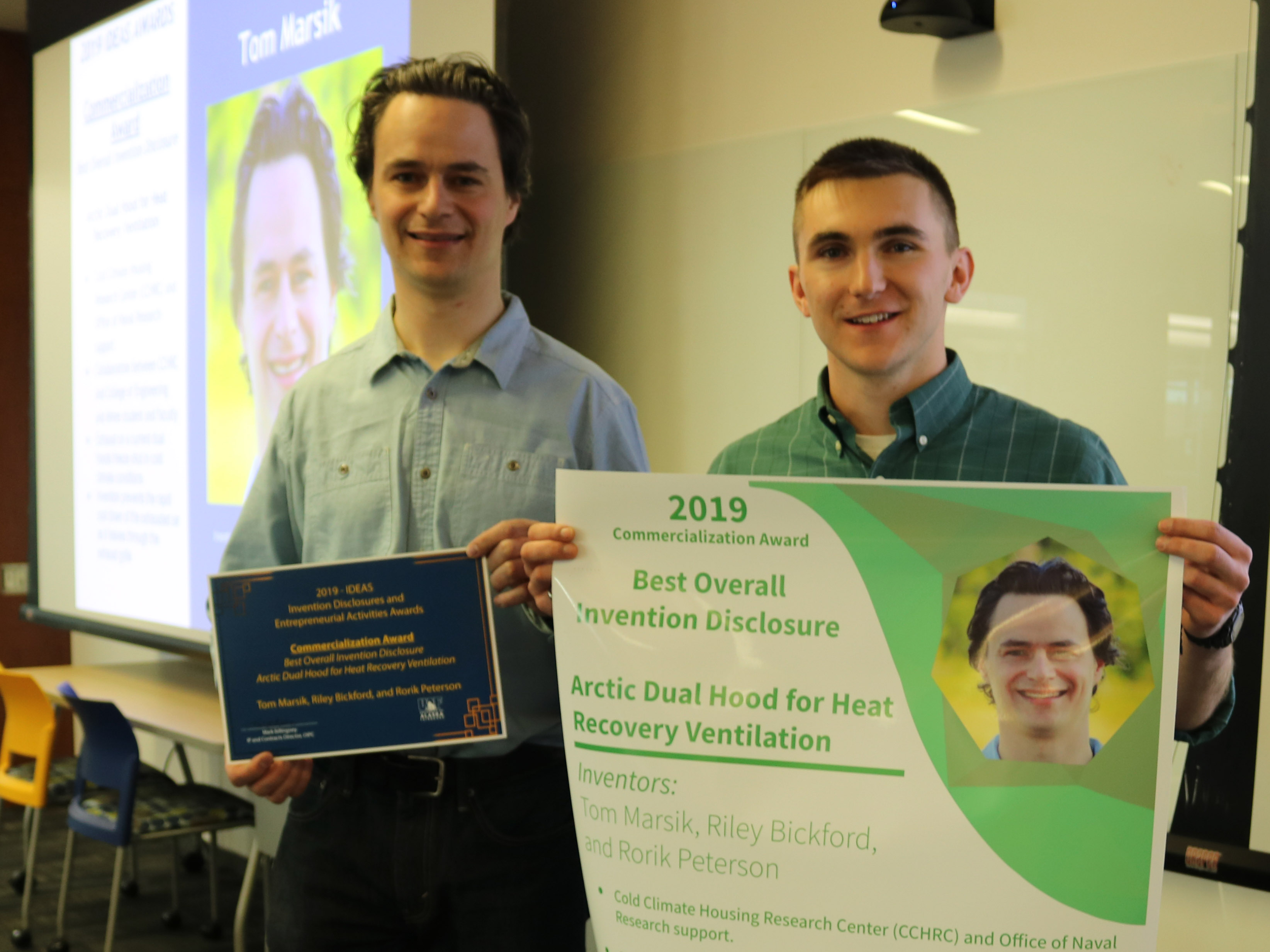
Tom Marsik and Riley Bickford won the Top Overall IDEAs Award for their dual hood HRV. Photo by Amanda Byrd.
This year’s UAF top Innovative Disclosures and Entrepreneurial Activities (IDEAs) Award went to Tom Marsik, Riley Bickford, and Rorik Peterson for their design of a dual hood for heat recovery ventilators operating in arctic climates.
The winners were announced at a fun-filled World IP Day event on April 26, 2019, at UAF. The IDEAs Awards recognize UAF and UAS faculty, staff, and students who have developed and disclosed innovative approaches to research, teaching, and service.
This year’s winners are:
- Top Overall: Commercialization Award -Tom Marsik, Riley Bickford, and Rorik Peterson: Arctic Dual Hood for Heat Recovery Ventilation
- Top UAF: Nanook Award - Robert (Trey) Coker, Robert Wolfe, and Freddy Wolfe: MyoEon 1: Complete Nutrition for Ideal Body Composition, Functional Capacity, and Metabolic Health
- Top UAS: Spike Award - Matthew R. Pawlus and Shane Bennett: Nematode Biosensor for Shellfish toxin home kit
- Top Faculty: Inspiration Award - Andrew McDonnell: Ocean Carbon Capture Reactor
- Top Staff: Creative Award - Sam Jeffries: Universal Payload Mount for Griffon SeaHunter
- Top Young Innovator: Tomorrow’s Innovator Award - Riley Bickford, Cory Florence, Sam Kendall, and David Woo: Avy Pouch
Next year’s competition is already underway, so enter here.
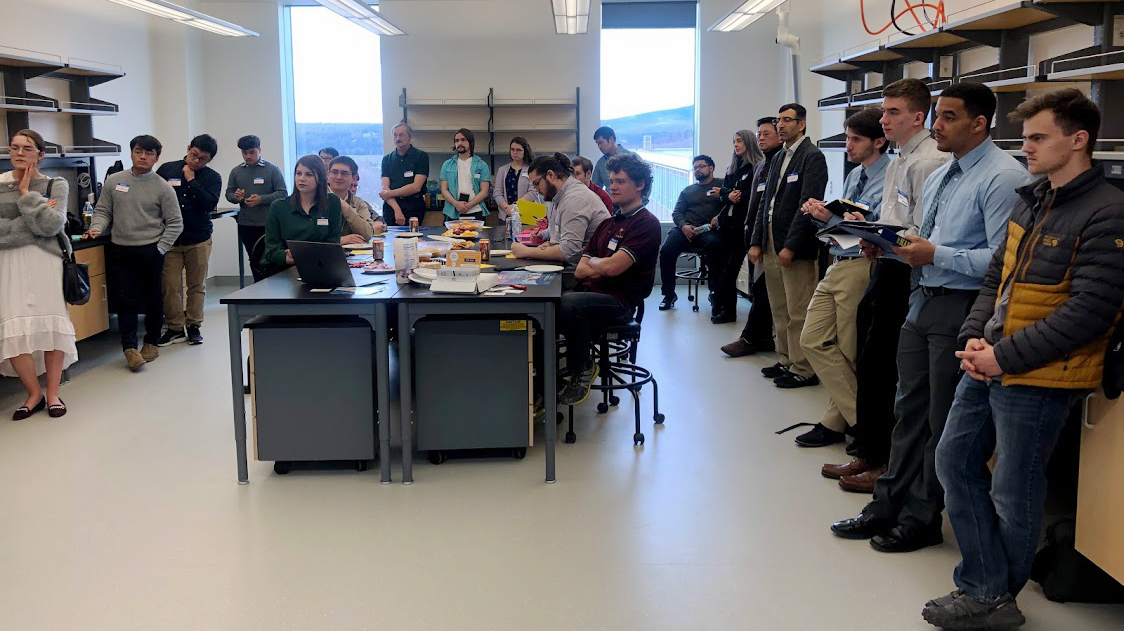
Students watch a pitch by a startup company before starting interviews. Photo by Kernell Snow.
The first Students2Startups event successfully brought together 25 students and 9 startup companies.
Companies started by pitching their internship opportunities. Then students and companies broke off into multiple rounds of “speed dating.” Companies located outside of Fairbanks participated virtually through video conferencing.
Now companies and students that paired up are formulating work plans and preparing for the summer internships.
“Along with the excitement, the mixer gave me a deeper insight into the startup industry and its unlimited pathways. I could practice my elevator pitches and interviewing skills, and learned about incredible innovations and opportunities all aiming to positively impact society,” said student Gerald Montuya, who landed a job with Barati Medical, LLC.
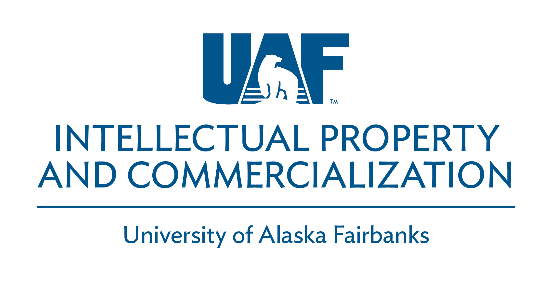 Piloted during the 2018-19 academic year, the UA Community Challenge program curates
problems from industry and matches them with faculty, staff, and student expertise.
A primary focus is on matching industry problems with students’ senior capstone project
coursework, independent study courses, and non-credit research projects – some of
which are required by departments including engineering, business, and biology.
Piloted during the 2018-19 academic year, the UA Community Challenge program curates
problems from industry and matches them with faculty, staff, and student expertise.
A primary focus is on matching industry problems with students’ senior capstone project
coursework, independent study courses, and non-credit research projects – some of
which are required by departments including engineering, business, and biology.
For more information, to submit your challenge, or to check out a list of current challenges, visit Alaska Center ICE Community Challenge.
For more information, contact hrholland@alaska.edu or call (907) 727-2735.
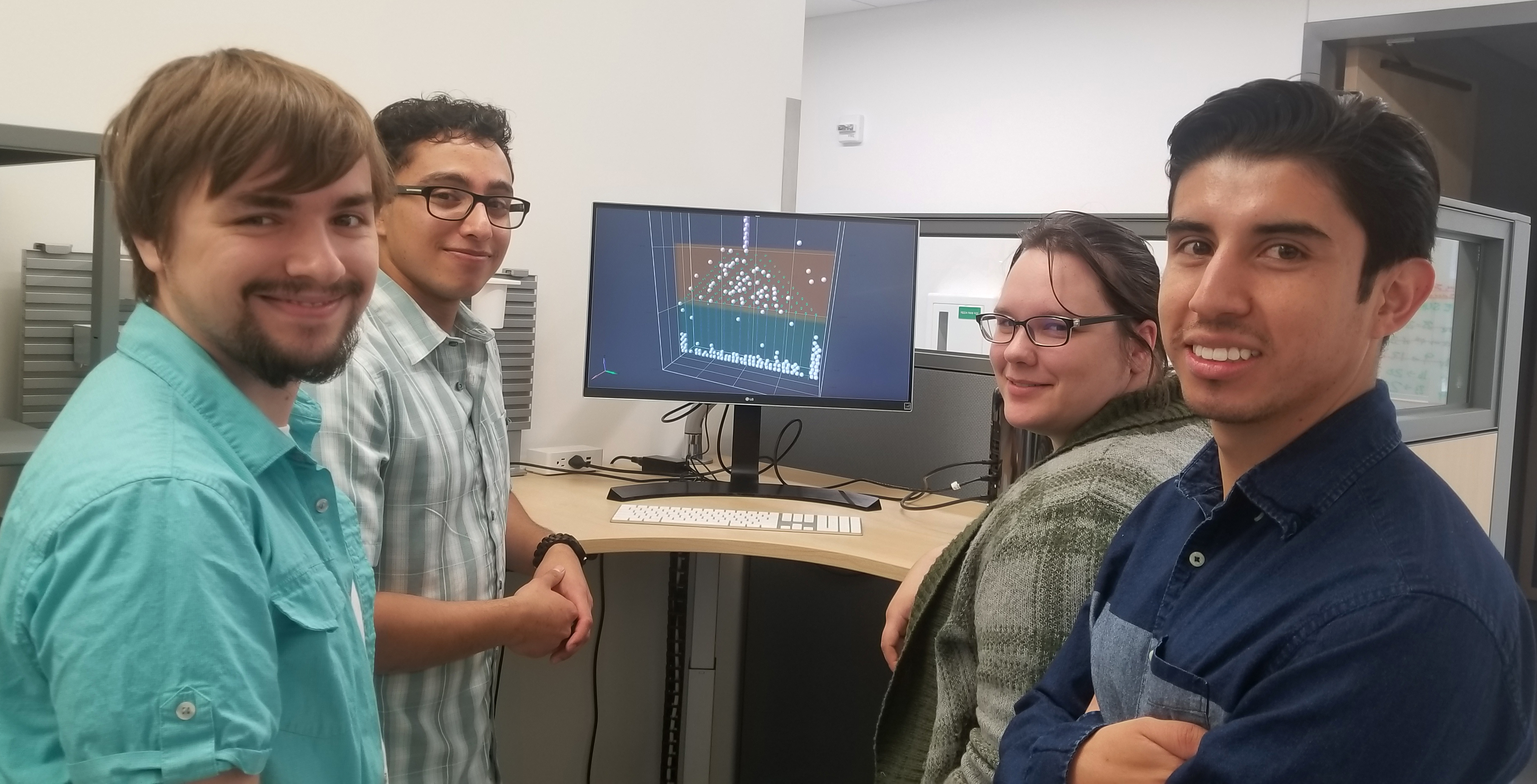
UAF startup Coupi hired local engineering student interns to move their innovation toward being market ready. Photo by Amanda Byrd.
Innovation and entrepreneurialism are a growing focus, service, and asset for universities around the country and across the world. Here’s a brief sampling of unique approaches some universities are taking:
The University of Utah has an integrated academic program, extracurricular program, and dormitory to fully immerse students.
- The University of Washington has all its innovation and entrepreneurial functions, including its technology commercialization office, rolled into “CoMotion” to offer a full stack of services and opportunities in one place.
- The Florida High Tech Corridor is a regional economic development initiative that brings together three universities and industrial resources with the aim of developing research, workforce, entrepreneurship, and industry innovation.
Let’s use these inspiring models to build a stronger innovation economy in Alaska.
 "Throughout my time at Alaska Center ICE, I have learned a lot about the startup experience
and cultivated an entrepreneurial spirit. I have also had the opportunity to be more
creative and critical with my ideas when dealing with projects. Center ICE challenged
me to become more driven and passionate about my goals, driving me to be the best
version I can be," said Kernell Snow, who joined Center ICE this academic year with
a charge of helping Nigel Sharp build out Center ICE's programming and support services.
"Throughout my time at Alaska Center ICE, I have learned a lot about the startup experience
and cultivated an entrepreneurial spirit. I have also had the opportunity to be more
creative and critical with my ideas when dealing with projects. Center ICE challenged
me to become more driven and passionate about my goals, driving me to be the best
version I can be," said Kernell Snow, who joined Center ICE this academic year with
a charge of helping Nigel Sharp build out Center ICE's programming and support services.
"It was easily one of the most impactful experiences of my life thus far. I learned a lot through Nigel [Sharp] and the OIPC team in terms of creativity, grit, and professionalism. All of which powered my growth as a student, a worker, and a person," said Kernell.
April
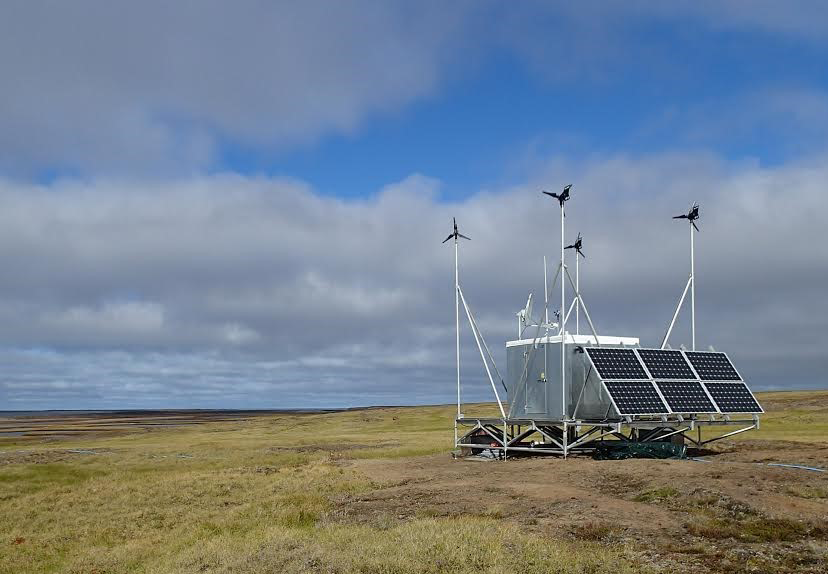
The Remote Power Module co-designed by Seth Danielson. Photo by Hank Statscewich, UAF.
The Alaska State Committee on Research Innovator’s Hall of Fame 2019 inductees were announced in February and included three new members from UAF: Dr. Jerome Johnson, Dr. Seth Danielson, and Dr. Matthew Sturm.
Sturm has studied snow and developed better ways to measure it. His achievements include identifying causes of avalanches, discovering new forms of snow crystals, and publishing well over 100 journal articles – many with widespread impact. He co-authored a book, Finding the Arctic, to communicate snow science to the general public, and a children’s book, Apun – The Arctic Snow, that teachers are able to use in their classrooms. As an entrepreneur, Sturm, along with Jon Holmgren, co-founded the company Snow-Hydro LLC to develop a self-recording snow depth probe and the snow temperature and depth probe which are sold worldwide through Snow-Hydro.
Danielson played essential, early roles in the conceptualization and development of the Remote Power Module (PDF) (RPM) – initially inducted in the 2014-15 class of the Alaska Innovators Hall of Fame. The RPM is an autonomous power generation unit collaboratively designed, built, and tested by UAF Professor Emeritus Thomas Weingartner, Danielson, and a technical team led by university research analyst Hank Statscewich. The RPM units are deployed in remote regions, typically without road and vehicle access (aside from snowmachines, skiffs, or 4-wheelers).
Johnson, a co-founder and CEO of startup company Coupi, Inc., was inducted for his research and innovation contributions in snow and soil strength in relation to infrastructure development and human interactions, development of the discrete element method model and its applications including in the design of NASA’s Mars Rover, and for his awards and distinctions that have helped put Alaska research on the world stage.
Cheers to these distinguished leaders of innovation in Alaska!
 The Alaska Seed Fund is seeking applications for $50,000 in grant money to help inventors
and entrepreneurs fund the development of prototypes in Alaska.
The Alaska Seed Fund is seeking applications for $50,000 in grant money to help inventors
and entrepreneurs fund the development of prototypes in Alaska.
In 2019, the fund will award one grand prize of $20,000 and up to 10 additional grants of between $3,000 and $10,000. The deadline for applications is April 14.
The University of Alaska Fairbanks Office of Intellectual Property and Commercialization administers the Alaska Seed Fund. Wells Fargo and the 49th State Angel Fund provide the funding for the awards.
Members of the public and the university community are eligible to apply for the grants, which aim to help support the development of new products and high-growth companies in the state. Representatives from UAF, the Alaska Small Business Development Center and the private sector will evaluate applications based on commercialization potential and feasibility.
Additional information, including the online application form and evaluation criteria, is available online at www.alaskaseedfund.com or by email to info@alaskaseedfund.com.

UAF Photo: Kelly Drew (right) and a student work with an arctic ground squirrel.
Dr. Kelly Drew, a professor at UAF’s Institute of Arctic Biology, has been accepted into the National Institutes of Health’s National I-Corps program. The program prepares researchers to move their NIH-funded research projects beyond the laboratory and toward commercialization.
NIH’s I-Corps program provides funding, mentoring, and networking opportunities to help commercialize promising biomedical technologies. During the 8-week, hands-on program, Drew and her team will learn how to focus their business plan and get the tools to bring her treatment to the patients who need it most.
Drew, along with principal investigator and post-doctoral student Bernard Laughlin, has developed a technology for body-temperature cooling that could be used to help patients with heart, brain, and spinal injuries. Congratulations Dr. Drew!
 Through your research at UAF and UAS, you may be sitting on some commercially valuable
innovations. These innovations can help both you and the university. In fact, your
innovations could be world-changing.
Through your research at UAF and UAS, you may be sitting on some commercially valuable
innovations. These innovations can help both you and the university. In fact, your
innovations could be world-changing.
After you disclose your innovation to OIPC, we’ll handle just about all the legwork including patenting and commercialization. Just let us know what you are working on. Disclose Now!
Who: UAF and UAS faculty, staff, and students from all departments
What: Anything that you’ve created. If you aren’t sure, then don’t hesitate to ask us (uaf-oipc@alaska.edu or 474-2605). The range of what can or should be disclosed is far broader than you think. Also, you can err on the side of disclosing, and we’ll just follow up with you to talk about it.
How: So simple. Just visit and fill out the form.
When: Now! Err on the earlier side because waiting can undermine intellectual property rights.
Why: We can help turn your research into reality! And so many other reasons: it’s required by federal regulation, it might result in a publication under your name, you could earn financial royalties, it helps your college or department, it contributes to economic development, you can be entered at your discretion into an annual innovation competition with cash prizes, and more.

A Mission Model Canvas from the 2019 Lean Launch Workshop. Photo by Ky Holland.
This year’s Lean Launch Workshop (LLW) tackled significant organizational and social challenges. Participants formed into three teams to focus on different issues: the Fairbanks PM2.5 particulate air quality problem, improving the process for implementing innovations in existing organizations, and providing native artists a solution for authentic branding and promotion of their arts.
Participant Jennifer Moss, an instructional designer at UAF’s eCampus, captured her experience here.
The Workshop was hosted by Center ICE and facilitated by BMNT’s Phil Dillard from March 11-13.
Teams will continue with follow up activities over 90 days to explore more of the challenges of sustaining the initial innovations and executing on the ideas. While the teams work together, individuals will be thinking about the process and how it can affect their own pursuits.
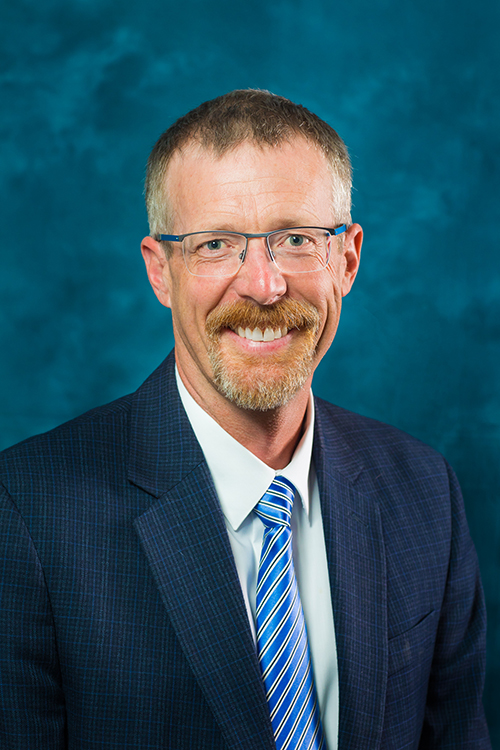
UAF photo: Chancellor Dan White.
UAF faculty, staff, and students are invited to join UAF Chancellor Dan White and OIPC staff for coffee, refreshments, and informal conversations about innovation at UAF. Stop by on Wednesday, April 3rd, from 8:30 to 9:30 a.m. in Signers’ Hall room 330. Email uaf-oipc@alaska.edu for more information.

Wearing eye protection against an intensely green laser, Jonathan Kamler examines a new, not-yet-silvered, capillary. After internal silvering, the capillary will be the photonic-waveguide core of the prototype spectroscopy gas flow cell that Kamler is validating through the NSF I-Corps program. Photo courtesy of Jonathan Kamler.
Few university researchers know how to turn their discoveries into commercial successes, and even fewer start their research with commercialization in mind. The National Science Foundation understands their dilemma, understands the unrealized value locked away in countless labs, and provides a framework for researchers to unlock commercial potential: Innovation Corps.
Jonathan Kamler joined UAF’s first NSF I-Corps cohort in January 2019 in order to explore the commercial potential for one of his innovations.
Kamler, a Ph.D. candidate in the UAF School of Natural Resources and Extension, is based in Juneau and studies gasification efficiency at UAF’s Palmer lab. Kamler didn’t start his technology journey with a commercial idea in mind, rather he simply needed to record split-second gas changes for his own research. Chemical processes happen extremely fast in gasification, and Kamler needed an instrument to monitor those changes. Commercially available options for Kamler were few, were prohibitively expensive, and might not have even worked. And, while he could build his own, starting from scratch was daunting and costly.
While searching for options, Kamler explained his plight to research colleagues at the National Energy Technology Laboratory. NETL researchers had been developing technology specifically to address fast gas analysis, and with small changes, Kamler thought it could work for his needs. He devised modifications to NETL’s approach in order to make it simpler, easier to build, and less expensive. It worked.
Working on this issue with NETL turned out to be a Win-Win-Win. Win 1: Kamler got an affordable tool that worked. Win 2: NETL got proof of concept of their process for the manufacturing sector. Win 3: Kamler was able to explore how he might turn this adaptation of NETL’s approach into a commercially viable product.
There was, however, still a gap between Kamler’s technology and finding an actual market need. This gap is now being addressed through the I-Corps program. Through I-Corps, researchers can deductively bridge the gap of assumptions and actually test whether or not there is a market nexus between their innovative ideas and real-world needs.
As a participant in I-Corps, Kamler chose to test customer validation for his innovation with companies that produce spectroscopy equipment. This past February, he attended the SPIE Photonics West Expo in San Francisco, where major equipment manufacturers were in attendance with exhibits and booths. Kamler interviewed numerous company representatives and discovered that spectroscopy equipment manufacturers appear to be the wrong point in the supply chain to pursue.
“My initial assumptions for this one customer segment were quickly proven wrong," Kamler explained. “That’s a whole market segment I don’t have to worry about now. I could have spent ten years and a lot of money finding that out myself. With the help of the I-Corps structure and mentoring, I was able to directly figure that out quickly.”
Customer validation involves talking to potential customers and even competitors to learn about their problems or ‘pains’ that an innovative idea might be able to solve. Kamler learned a lesson: while the trade show did not yield any potential customers with the right ‘pain’, the I-Corps interviewing process helped him discover that process equipment suppliers were likely a better market to explore.
Kamler said that “I-Corps helps determine whether the market is there and potentially saves you years and years of trial and error”.
Prior to Kamler’s innovative development, there were no straightforward or affordable instruments to analyze gas compositions with split-second accuracy. While the commercial potential of his device remains an open question, he took a positive step forward by scratching one market segment off his working list. Kamler will continue to narrow his list in an effort to identify a viable market that will support a successful, commercial enterprise.
Email centerice@alaska.edu for more information.
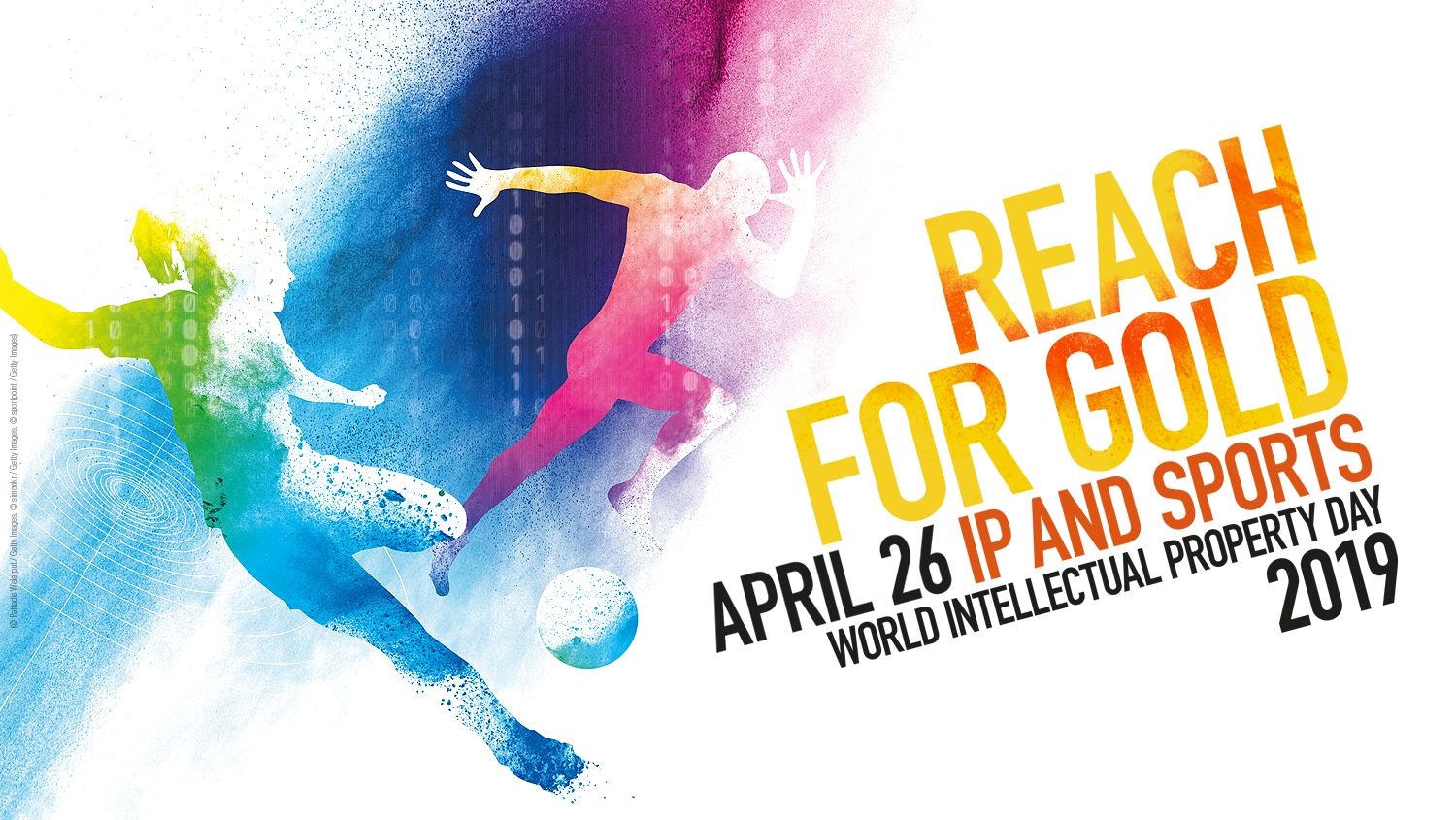 April 26 is a day to celebrate the role that intellectual property (IP) rights play
in encouraging innovation and creativity.
April 26 is a day to celebrate the role that intellectual property (IP) rights play
in encouraging innovation and creativity.
This year’s World Intellectual Property Day campaign - Reach for Gold – takes a closer look inside the world of sports. It explores how innovation, creativity and the IP rights that encourage and protect them support the development of sport and its enjoyment around the world.
Alaska has a strong sports innovation history including the celebration of the World Eskimo Indian Olympics, sled dog races like the Iditarod and Yukon Quest, bore-tide surfing, heli-skiing, and much more.
On April 26, play your favorite sport, take a photo and share it with #worldipday and #oipcUAF! Let's show the rest of the world how innovative Alaska really is!
March
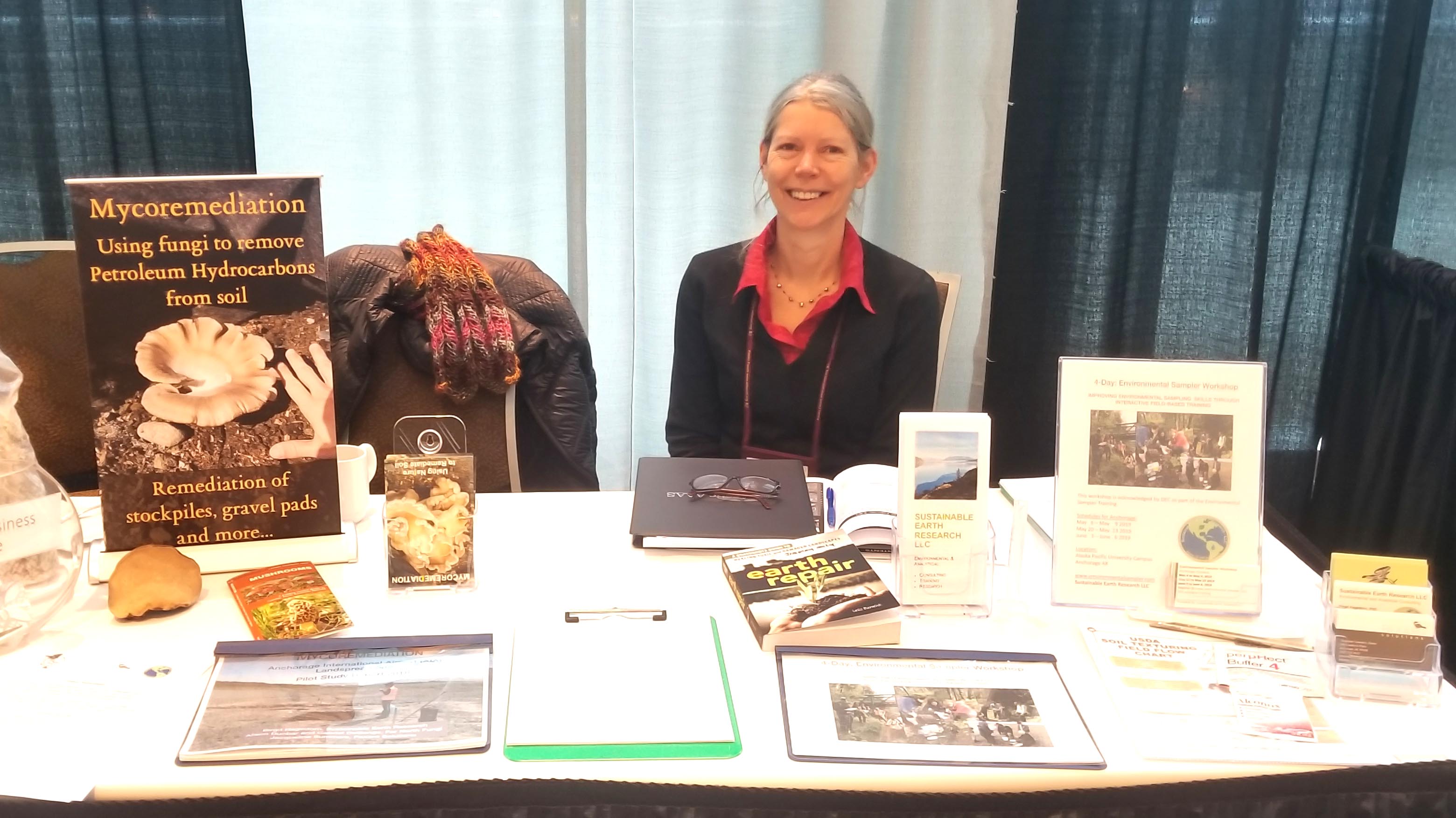
Birgit Hagedorn used funding from the Center ICE Seed Fund to pay for her booth a the Alaska Forum on the Environment. Photo by Amanda Byrd.
In March 2018, Birgit Hagedorn attended Center ICE’s first Lean Launch Workshop with two fungi farmers with the idea of using fungus for bioremediation of petroleum hydrocarbons - gasoline, diesel, and crude oil. The workshop proved to mushroom the idea into a real business concept.
Hagedorn, an environmental geochemist and scientist with more than 25 years of research and field experiences in polar and temperate environments, proposed the idea to Far North Fungi’s Gabe DeGange and Allison Dunbar at looking at mushrooms as a tool for bioremediation. Gange and Dunbar, who had already thought about this, jumped at the opportunity to move this idea forward.
The goal was to develop a cheap, rugged and universal remediation technique to be applied in remote areas without the need of large equipment and intensive oversight and an end product of fully restored soil ecosystem: all at lower costs than traditional remediation.
The LLW pairs teams with business savvy mentors and the Team Fungi was assigned business consultant Jacqueline Summer of Paxaro Solutions.
“Without the Lean Launch Workshop we would not have made it this far, says Hagedorn during a phone interview. “This is where I met Jaqueline and she is the one with the business head.”
During the three-day workshop, teams were required to cold-call potential customers to find out if they had any issues or needs that could potentially be met by their idea.
This cold calling introduced the team to very potential customers, even landing them a test project at Anchorage International Airport cleaning contaminated soil with the mushrooms. This success inspired the team to press on, calling themselves the Fungi Alliance.
They received a Center ICE Seed Fund grant which helped pay for a booth at the Alaska Forum on the Environment (AFE). The booth received a lot of attention including an offer to contribute to a bioremediation project in central Alaska.
“We now have more contacts than we can follow up with, this is a good problem to have,” says Hagedorn.
The team participates in a first round of the I-Corps program that includes $2,500 in travel funds for customer discovery, and two 3.5 to 4 hours sessions with Nigel Sharp to learn more about the Business Model Canvas and do more customer discovery.
“We might already be too far ahead in our business, had we started right after the lean launch Workshop with the I-corps program with its intensive customer discovery program would be much more effective,” Says Hagedorn.
In addition to the participation in the AFE conference, the next steps for the team are to continue product development and research which is also supported by the seed fund. The reality of getting a real project includes figuring how they want to operate as a business, taking steps to make formal agreements, working out accounting, how to get paid, insurance and who should carry insurance.
The idea is now a reality, and a better bioremediation method for hydrocarbons may have been developed right here in Alaska. Find out more about the Fungi Alliance here.
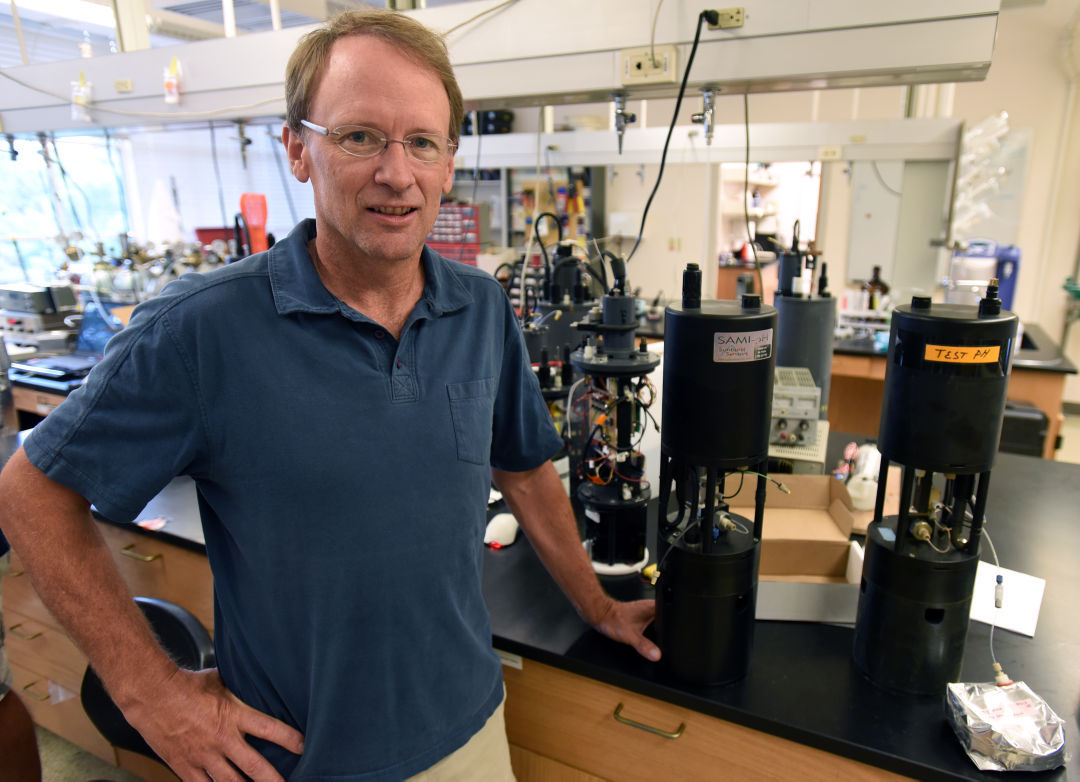
Michael DeGrandpre of the University of Montana will be the next I2 speaker. Photo from https://missoulian.com.
The next Innovation Initiative (I2) event will be at 4:30 p.m. in the BP Design Theater, ELIF 401 on the UAF campus, and will feature Michael DeGrandpre.
DeGrandpre is an analytical chemist at the University of Montana specializing in autonomous sensors for studying aquatic biogeochemistry and the ocean carbon cycle. His presentation will be on his SAMI-CO2 sensor invention and his successful startup company, Sunburst Sensors.
Come learn about DeGrandpre’s fascinating research, award-winning innovation, and the path to commercial success. DeGrandpre’s presentation will be followed by refreshments and an opportunity for informal conversation.
For more information, please contact OIPC Ambassador, Peter Webley.
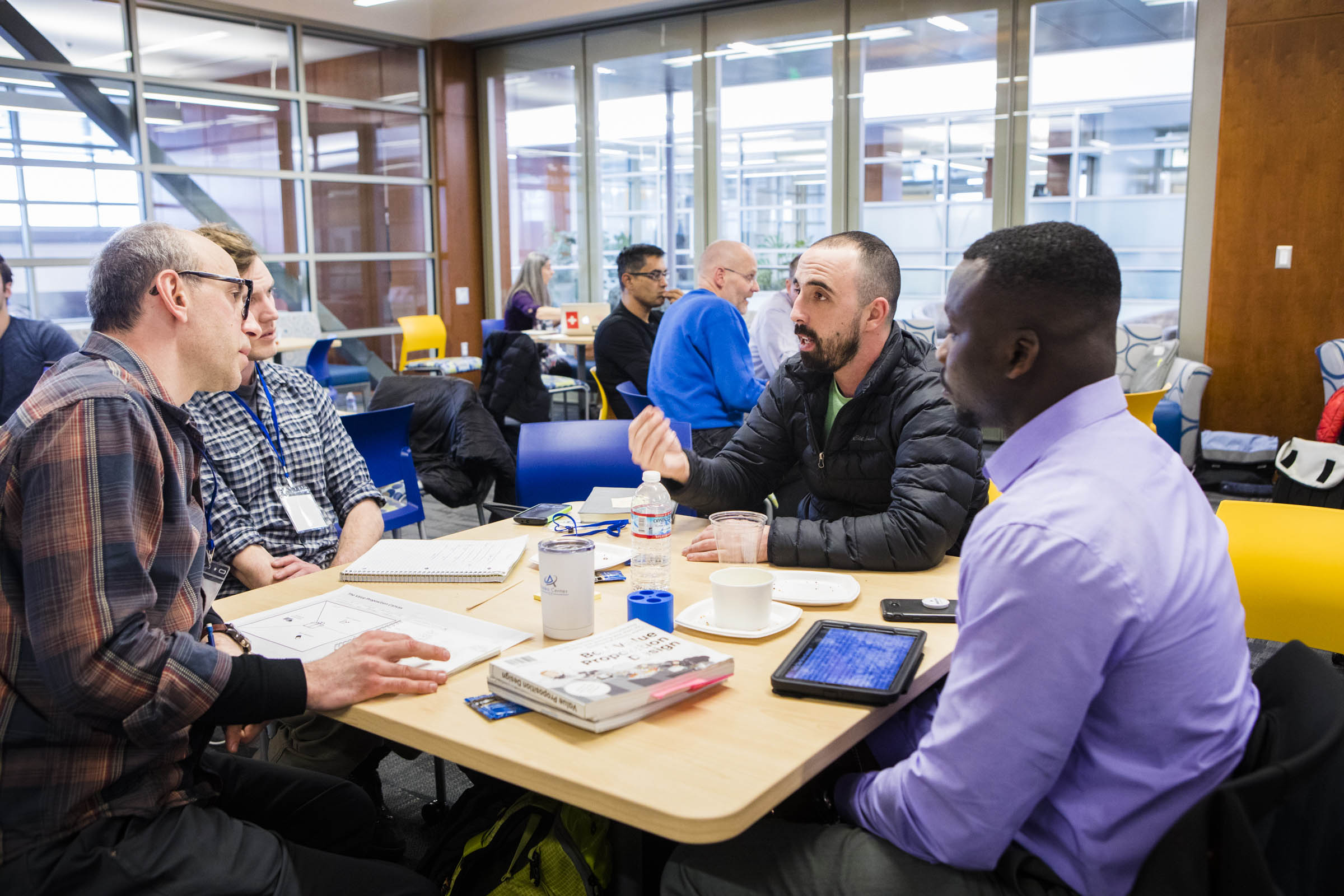
A team discusses its innovation during the 2018 Lean Launch Workshop. Photo by JR Ancheta.
Do you have an innovative idea that you think has business potential? Are you looking for the tools to turn an idea into a commercial reality?
The 2019 Lean Launch Workshop will get you where you want to go. Offered March 11th – 13th on the UAF campus, the workshop teaches Stanford’s widely-adopted Lean Startup Methodology – techniques used by tech-based startups around the world.
This workshop is open to all faculty, staff, students, and members of the public.
This year’s workshop will introduce the Mission Model Canvas tool for open innovation between entrepreneurs and corporate and government partners. You’ll learn techniques for customer discovery, how to work through the challenges of new venture creation, how to build an investable venture with high performing founding teams, and who to partner with.
Apply by March 1st at Center Ice

Nigel Sharp and Kernell Snow met potential interns at the UAF Spring Internship Fair. Photo courtesy of Nigel Sharp.
The Alaska Center for Innovation, Commercialization, and Entrepreneurship (Center ICE) is launching a new internship program called Student2Startups, where students will get a chance to work directly with an array of startups in Alaska.
Center ICE hosts a variety of startups that are working in fields ranging from biomedical technology, software, and engineering sciences, to financial research.
An intern can expect to gain valuable experience in their fields of interest, as well as learn more about the world of start-up companies and cutting-edge innovation.
Find out more at Center ICE.
 The 2019 Innovative Disclosures and Entrepreneurial Activities (IDEAS) Awards recognize
entrepreneurial individuals who have developed innovative approaches to research,
teaching, and service.
The 2019 Innovative Disclosures and Entrepreneurial Activities (IDEAS) Awards recognize
entrepreneurial individuals who have developed innovative approaches to research,
teaching, and service.
To be eligible for the IDEAS awards, faculty, staff, and students need to have disclosed their technology through UAF’s Office of Intellectual Property and Commercialization before March 31, 5 pm Alaska time.
IDEAS awards will recognize innovative solutions in the following categories:
- Commercialization Award: Best overall
- Nanook Award: All from UAF
- Spike Award: All from UAS
- Tomorrow’s Innovator Award: All students and post-doctoral researchers
- Inspiration Award: All Faculty
- Creative Award: All Staff
Successful awardees will be notified by April 15, 2019 with an awards ceremony at the UAF Center for Innovation, Commercialization, and Entrepreneurship in May 2019. If you have any question about disclosing your innovation or the 2019 IDEAS awards, please contact us at uaf-oipc@alaska.edu or visit Ideas Alaska.
 The Alaska Seed Fund plans to award a total of $50,000 to innovators and entrepreneurs
for the development of prototypes in Alaska. One grand prize winner will receive a
$20,000 Seed Grant. Additionally, we will award up to 10 other applicants ranging
from $3,000 to $10,000. The application and eligibility information may be found at
Alaska Seed Fund.
The Alaska Seed Fund plans to award a total of $50,000 to innovators and entrepreneurs
for the development of prototypes in Alaska. One grand prize winner will receive a
$20,000 Seed Grant. Additionally, we will award up to 10 other applicants ranging
from $3,000 to $10,000. The application and eligibility information may be found at
Alaska Seed Fund.
The Alaska Seed Fund is brought to you by Wells Fargo, the 49th State Angel Fund, OIPC, and the Alaska Small Business Development Center. If you have any questions on the Alaska Seed Fund please see the FAQ online.
Applications must be submitted by April 14th at 11:59 p.m.
Special Thanks to our Sponsors:
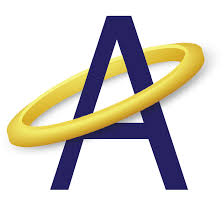
![]()

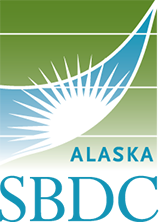
February
 Alaska Center ICE office space is in high demand. We currently have three tenants
using the office space to conduct their business activities. Our tenants include Essential
Blends, Be Cool, and Coupi, Inc.
Alaska Center ICE office space is in high demand. We currently have three tenants
using the office space to conduct their business activities. Our tenants include Essential
Blends, Be Cool, and Coupi, Inc.
 Essential Blends develops and commercializes clinical nutrition products, targeting
specific health issues such as obesity, sarcopenia, heart failure, and liver disease.
Essential Blends leads Alaska in Small Business grants from the National Institutes
of Health, with some of their subawards extending to UAF. The company maintains its
focus on research and development while leveraging licensing agreements with several
medical nutrition/pharma companies. In May of 2013, Robert Coker, Ph.D., co-founded
Essential Blends LLC with partners in California and New Zealand.
Essential Blends develops and commercializes clinical nutrition products, targeting
specific health issues such as obesity, sarcopenia, heart failure, and liver disease.
Essential Blends leads Alaska in Small Business grants from the National Institutes
of Health, with some of their subawards extending to UAF. The company maintains its
focus on research and development while leveraging licensing agreements with several
medical nutrition/pharma companies. In May of 2013, Robert Coker, Ph.D., co-founded
Essential Blends LLC with partners in California and New Zealand.
![]() Coupi is a startup company focused on consulting, modeling, and simulation in the
fields of particle physics, solid mechanics, and fluid dynamics to help customers
optimize products and processes, reduce product development time and costs, and improve
innovation and productivity. Coupi relies on its in-house developed computer-aided
engineering software to simulate complex products and processes to help with customer
projects and challenges. Coupi has a history of working with NASA, DOE, Cornell Univ.,
Johns Hopkins, Honeybee Robotics, Analytical Mechanics Associates, and other organizations
and companies.
Coupi is a startup company focused on consulting, modeling, and simulation in the
fields of particle physics, solid mechanics, and fluid dynamics to help customers
optimize products and processes, reduce product development time and costs, and improve
innovation and productivity. Coupi relies on its in-house developed computer-aided
engineering software to simulate complex products and processes to help with customer
projects and challenges. Coupi has a history of working with NASA, DOE, Cornell Univ.,
Johns Hopkins, Honeybee Robotics, Analytical Mechanics Associates, and other organizations
and companies.
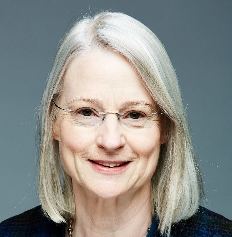 Be Cool Pharmaceuticals is a startup company created by Kelly Drew (left) that explores
the receptors that regulate the onset of hibernation in Arctic ground squirrels. They
are now building on that knowledge to pursue a medical solution for human victims
of stroke, cardiac arrest, and spinal cord injury. Be Cool is developing compositions
and methods that may allow humans to drift into a hibernation-like state. This strategy
would help ward off the negative effects of the injury and minimize permanent damage
until proper and complete medical service is available. This innovation will be highly
valuable among, for example, rural and remote communities.
Be Cool Pharmaceuticals is a startup company created by Kelly Drew (left) that explores
the receptors that regulate the onset of hibernation in Arctic ground squirrels. They
are now building on that knowledge to pursue a medical solution for human victims
of stroke, cardiac arrest, and spinal cord injury. Be Cool is developing compositions
and methods that may allow humans to drift into a hibernation-like state. This strategy
would help ward off the negative effects of the injury and minimize permanent damage
until proper and complete medical service is available. This innovation will be highly
valuable among, for example, rural and remote communities.
If you are interested in renting lab or office space at Center ICE, please contact Nigel Sharp and nigel.sharp@alaska.edu.
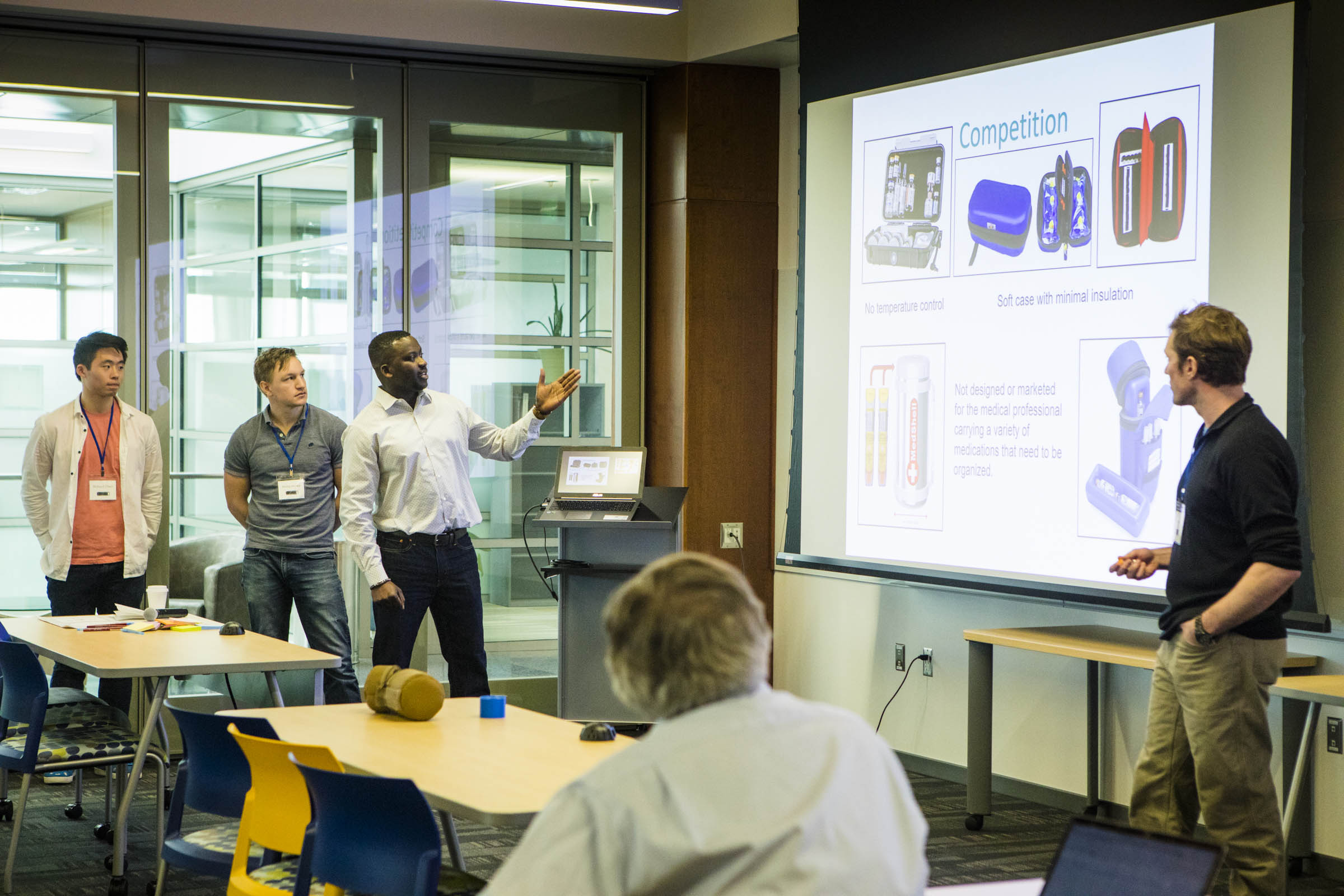
A team including three UAF undergraduate students present its ideas at the 2018 Lean Launch Workshop. Photo by JR Ancheta.
Center ICE will hold its second annual Lean Launch Workshop during spring break on March 11th to 13th.
Do you have a business challenge or are willing to help others with their opportunity? This year's Lean Launch Workshop: Innovation to Launch, is looking for challenges and innovators who want to learn and use lean launch methods of innovation and new venture creation.
Participants from last year's workshop are encouraged to attend, and anyone with a new venture idea or early-stage startup company. When you apply, you'll be asked to submit your current challenges that we may choose to focus on in the workshop. Even if your challenge is not fully used, the work before, during, and after the workshop online will provide you tools, information and feedback to assist you with your own innovations. Facilitated by the BMNT group, this year's workshop will focus on the challenges of launching a new venture using the Stanford Lean Launch models with a goal to help create investable (by founders, employees, investors, and customers) new ventures with high performing founding teams, an operating system and plan for execution, and strategic partnerships (other startups, vendors, departments, licensing etc.).
Learn more and apply at Center ICE.
 The Center ICE Seed Fund awarded 8 grants, $5,000 to $25,000, in the fall of 2018
to University and community innovators working on commercialization or technical challenges
that needed a "nudge" to make some critical progress. The Fund is accepting additional
proposals due February 15th for consideration and award at the Innovation Summit in
Juneau on February 22, 2019. Visit Center ICE for more information and to apply.
The Center ICE Seed Fund awarded 8 grants, $5,000 to $25,000, in the fall of 2018
to University and community innovators working on commercialization or technical challenges
that needed a "nudge" to make some critical progress. The Fund is accepting additional
proposals due February 15th for consideration and award at the Innovation Summit in
Juneau on February 22, 2019. Visit Center ICE for more information and to apply.
 Alaska's first Angel Conference is seeking Alaskan entrepreneurs and new ventures
to apply for an investment of $100,000. The Angel conference is an established program
in the northwest U.S. that helps new investors and new entrepreneurs learn about early
stage company financing. Weekly workshops have started and are open to anyone interested
in attending in person in Anchorage, Fairbanks, and Juneau, or by Zoom online video
session. Sessions are being recorded so you don't miss anything.
Alaska's first Angel Conference is seeking Alaskan entrepreneurs and new ventures
to apply for an investment of $100,000. The Angel conference is an established program
in the northwest U.S. that helps new investors and new entrepreneurs learn about early
stage company financing. Weekly workshops have started and are open to anyone interested
in attending in person in Anchorage, Fairbanks, and Juneau, or by Zoom online video
session. Sessions are being recorded so you don't miss anything.
Currently, the organizers are looking for early-stage companies interested in equity or revenue redemption (debt) financing to apply. Learn more and apply at Alaska Angel Conference.
 I-Corps at NIH is an experiential entrepreneurship program designed for small businesses in biomedical
industries. By conducting 100 “customer development” interviews over 8 weeks, companies
find and confirm customer and market needs. So far, more than 100 teams have conducted
more than 10,000 interviews, through which they have made new networks, established
new partnerships, and built commercialization plans for their innovative technologies.
Small businesses with an ACTIVE Phase I SBIR/STTR grant from 19 NIH/CDC institutes and centers are eligible.
I-Corps at NIH is an experiential entrepreneurship program designed for small businesses in biomedical
industries. By conducting 100 “customer development” interviews over 8 weeks, companies
find and confirm customer and market needs. So far, more than 100 teams have conducted
more than 10,000 interviews, through which they have made new networks, established
new partnerships, and built commercialization plans for their innovative technologies.
Small businesses with an ACTIVE Phase I SBIR/STTR grant from 19 NIH/CDC institutes and centers are eligible.


